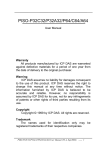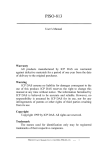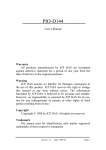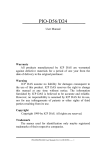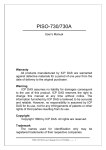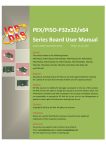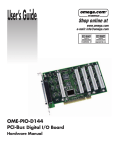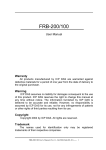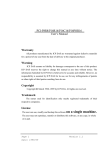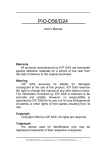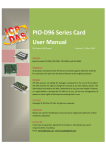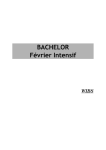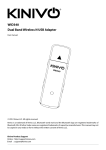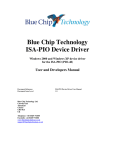Download Manual - Thiim A/S
Transcript
PISO-P32C32/P32A32/P64/C64/A64
User’s Manual
Warranty
All products manufactured by ICP DAS are warranted
against defective materials for a period of one year from
the date of delivery to the original purchaser.
Warning
ICP DAS assumes no liability for damages consequent
to the use of this product. ICP DAS reserves the right to
change this manual at any time without notice. The
information furnished by ICP DAS is believed to be
accurate and reliable. However, no responsibility is
assumed by ICP DAS for its use, not for any infringements
of patents or other rights of third parties resulting from its
use.
Copyright
Copyright © 1999 by ICP DAS. All rights are reserved.
Trademark
The names used for identification only may be
registered trademarks of their respective companies.
User’s Manual PISO-P32C32/P32A32/P64/C64/A64 9/9/2004 V3.2
1
Tables of Contents
1.
INTRODUCTION ............................................................................................................... 4
1.1
SPECIFICATIONS .............................................................................................................. 4
1.2
ORDER DESCRIPTION ...................................................................................................... 5
1.2.1
2.
Options.................................................................................................................. 5
1.3
PCI DATA ACQUISITION FAMILY ........................................................................................ 6
1.4
PRODUCT CHECKLIST ...................................................................................................... 7
HARDWARE CONFIGURATION ...................................................................................... 8
2.1
BOARD LAYOUT ............................................................................................................... 8
2.2
ISOLATED D/I ARCHITECTURE ......................................................................................... 11
2.3
ISOLATED D/O ARCHITECTURE ....................................................................................... 13
2.4
DAUGHTER BOARDS ....................................................................................................... 15
2.4.1
DB-37 ................................................................................................................... 15
2.4.2
DN-37................................................................................................................... 15
2.4.3
DB-8125............................................................................................................... 15
2.5
PIN ASSIGNMENT OF PISO-P32C32/P32A32................................................................. 16
2.6
PIN ASSIGNMENT OF PISO-P64 ..................................................................................... 17
2.7 PIN ASSIGNMENT OF PISO-C64/A64 .............................................................................. 18
3.
I/O CONTROL REGISTER............................................................................................... 19
3.1 HOW TO FIND THE I/O ADDRESS ..................................................................................... 19
4.
3.1.1
PIO_DriverInit ..................................................................................................... 20
3.1.2
PIO_GetConfigAddressSpace ............................................................................ 23
3.1.3
Show_PIO_PISO ................................................................................................ 26
3.2
THE ASSIGNMENT OF I/O ADDRESS ................................................................................ 27
3.3
ENABLEING I/O OPERATION ........................................................................................... 28
3.4
THE I/O ADDRESS MAP.................................................................................................. 28
3.4.1
PISO-P32C32/P32A32 I/O Mapping................................................................... 29
3.4.2
PISO-P64 I/O Mapping ....................................................................................... 30
3.4.3
PISO-C64/A64 I/O Mapping ............................................................................... 31
3.4.4
RESET\ Control Register .................................................................................... 32
3.4.5
AUX Control Register ......................................................................................... 32
3.4.6
AUX Data Register.............................................................................................. 33
3.4.7
INT Mask Control Register .................................................................................. 33
3.4.8
Aux Status Register ............................................................................................ 33
THE APPLICATIONS OF DIGITAL I/O........................................................................... 34
4.1 THE EXAMPLE OF PISO-P32C32/P32A32 ....................................................................... 34
User’s Manual PISO-P32C32/P32A32/P64/C64/A64 9/9/2004 V3.2
2
5.
4.2
THE EXAMPLE OF PISO-P64 .......................................................................................... 40
4.3
THE EXAMPLE OF PISO-C64/A64................................................................................... 43
DEMO PROGRAM .......................................................................................................... 48
5.1 PROGRAM FILE
FOR PISO-P32C32/P32A32 ................................................................. 48
5.2
PROGRAM FILE FOR PISO-P64....................................................................................... 51
5.3
PROGRAM FILE LIST FOR PISO-C64/A64 ........................................................................ 53
5.4
DIAGNOSTIC PROGRAM ................................................................................................... 55
5.4.1
Diagnostic program for DOS............................................................................... 55
5.4.2
Diagnostic program for WINDOWS .................................................................... 56
5.5
DEMO PROGRAM FOR PISO-P32C32/P32A32 ............................................................... 57
5.5.1
DEMO1 for PISO-P32C32/P32A32 .................................................................... 57
5.5.2
DEMO2 for PISO-P32C32/P32A32 .................................................................... 59
5.5.3
DEMO3 for PISO-P32C32/P32A32 .................................................................... 61
5.6
DEMO PROGRAM FOR PISO-P64 .................................................................................... 63
5.6.1 DEMO1 for PISO-P64............................................................................................ 63
5.7
DEMO PROGRAM FOR PISO-C64/A64 ............................................................................ 65
5.7.1 DEMO1 for PISO-C64/A64 .................................................................................... 65
User’s Manual PISO-P32C32/P32A32/P64/C64/A64 9/9/2004 V3.2
3
1.
Introduction
The PISO-P32C32 consists of 32 channels of isolated D/I & 32 channels
of isolated D/O (Current Sinking). The PISO-P32A32 consists of 32 channels
of isolated D/I & 32 channels of isolated D/O (Current Sourcing). The PISOP64 consists of 64 channels of isolated D/I. The PISO-C64 consists of 64
channels of isolated D/O (Current Sinking). The PISO-A64 consists of 64
channels of isolated D/O (Current Sourcing). The D/I specifications of PISOP32C32, PISO-P64 & PISO-P32A32 are the same.
1.1
Specifications
Isolated digital input
•
•
•
•
Input voltage: 5V to 30V
Input impedance: 3K
Isolation voltage
Using internal power: 3000V
Using external power: 3750V
Response time: 30K Hz max.
Isolated digital output
•
•
•
Isolation voltage: 3750V
Open collector output: 100 mA/30V per channel
Response time: 4K Hz typical
I/O channels
D/I channels
D/O channels
PISO-P32C32
32
32
PISO-P32A32
32
32
PISO-P64
64
0
PISO-C64
0
64
PISO-A64
0
64
User’s Manual PISO-P32C32/P32A32/P64/C64/A64 9/9/2004 V3.2
4
Other specifications
•
•
•
•
•
•
•
PC compatible PCI bus
Four isolated I/O banks
Operating Temperature: 0°C to 60°C
Storage Temperature: -20°C to 80°C
Humidity: 0 to 90% non-condensing
Dimensions
PISO-P32C32/P32A32: 180mm X 105mm
PISO-P64
: 180mm X 105mm
PISO-C64/A64
: 180mm X 105mm
Power Consumption
PISO-P32C32/P32A32: +5V @ 600mA (typical)
PISO-P64:
+5V @ 400mA (typical)
PISO-C64/A64:
+5V @ 800mA (typical)
1.2
•
•
•
•
•
PISO-P32C32: PCI bus with 32-bit D/I, 32-bit D/O (Current Sinking).
PISO-P32A32: PCI bus with 32-bit D/I, 32-bit D/O (Current Sourcing).
PISO-P64: PCI bus, 64-bit D/I.
PISO-C64: PCI bus, 64-bit D/O (Current Sinking).
PISO-A64: PCI bus, 64-bit D/O (Current Sourcing)
1.2.1
•
•
•
•
•
•
•
•
•
Order Description
Options
DB-24P, DB-24PD: 24 channel isolated D/I board
DB-24R, DB-24RD: 24 channel relay board
DB-24PR, DB-24PRD: 24 channel power relay board
DB-16P8R: 16 channel isolated D/I and 8 channel relay output board
DB-24POR: 24 channel Photo MOS output board
DB-24SSR: 24 channel Solid State output board
DB-24C: 24 channel open-collector output board
ADP-37/PCI: extender, 50-pin OPTO-22 header to DB-37 for PCI Bus I/O
boards
ADP-50/PCI: extender, 50-pin OPTO-22 header to 50-pin header, for PCI
Bus I/O boards
User’s Manual PISO-P32C32/P32A32/P64/C64/A64 9/9/2004 V3.2
5
1.3
PCI Data Acquisition Family
We provide a family of PCI-BUS data acquisition cards. These cards can
be divided into three groups as follows:
1. PCI-series: first generation, isolated or non-isolated cards
PCI-1002/1202/1800/1802/1602: multi-function family, non-isolated
PCI-P16R16/P16C16/P16POR16/P8R8: D/I/O family, isolated
PCI-TMC12: timer/counter card, non-isolated
2. PIO-series: cost-effective generation, non-isolated cards
PIO-823/821: multi-function family
PIO-D168/D144/D96/D64/D56/D48/D24: D/I/O family
PIO-DA16/DA8/DA4: D/A family
3. PISO-series: cost-effective generation, isolated cards
PISO-813: A/D card
PISO-P32C32/P32A32/P64/C64/A64: D/I/O family
PISO-P8R8/P8SSR8AC/P8SSR8DC: D/I/O family
PISO-730/730A: D/I/O card
PISO-DA2: Channel to Channel Isolated D/A card
User’s Manual PISO-P32C32/P32A32/P64/C64/A64 9/9/2004 V3.2
6
1.4
Product Checklist
In addition to this manual, the package includes the following items:
• One PISO-P32C32/P32A32/P64/C64/A64 card.
• One driver diskette or CD-ROM.
• One release note.
It’s recommended to read the release note first. All-important information will
be given in the release note. It tells:
1. Where you can find the software driver & utility.
2. How to install software & utility.
3. Where is the diagnostic program?
4. FAQ.
Attention!
If any of these items are missing or damaged, contact the
dealer from whom you purchased the product. Please
save the shipping materials and carton in case you want
to ship or store the product in the future.
User’s Manual PISO-P32C32/P32A32/P64/C64/A64 9/9/2004 V3.2
7
2.
Hardware configuration
2.1
Board Layout
The board layout of PISO-P32C32/P32A32 is as follows:
Digital input 0~15
Digital Output 0~15
JP1
LED1
LED2 DC/DC 1
PISO-P32C32/
PISO-P32A32
Digital Input 16~31
Digital Output16~31
DC/DC 2 LED3 LED4
JP2
CON2
40-PIN
CON1
DB-37
PCI BUS
Figure 2-1A. Board layout of PISO-P32C32/P32A32
JP1/JP2
INTERNAL
EXTERNAL
Default settling
LED1: Power indicator for DO_0
to DO_15
LED2: Power indicator for DI_0
to DI_15
LED3: Power indicator for DO_16 to DO_31
LED4: Power indicator for DI_16
to DI_31
JP1: Select internal/external power for DI_0 to DI_15 (3000V isolation)
JP2: Select internal/external power for DI_16 to DI_31 (3000V isolation)
Isolation bank 1: DI_0 to DI_15, Power=CON1_18, Ground=CON1_19
Isolation bank 2: DO_0 to DO_15, Power=CON1_37, Ground=CON1_1 &
CON1_20
Isolation bank 3: DI_16 to DI_31, Power=CON2_18, Ground=CON2_19
Isolation bank 4: DO_16 to DO_31, Power=CON2_37, Ground=CON2_1
&CON2_20
All four banks are fully isolated from each other.
User’s Manual PISO-P32C32/P32A32/P64/C64/A64 9/9/2004 V3.2
8
The board layout of PISO-P64 is as follows:
32 Channels
Digital Input
32 Channels
Digital Input
PISO-P64
LED1 LED2
J1
DC/DC 1
J2
LED3
LED4
J3
J4
CON2
40-PIN
CON1
DB-37
PCI BUS
Figure 2-1B. Board layout of PISO-P64
J1/J2/J3/J4
INTERNAL
EXTERNAL
Default
LED 1: power indicator for DI_0 to DI_15
LED 2: power indicator for DI_16 to DI_31
LED 3: power indicator for DI_32 to DI_47
LED 4: power indicator for DI_48 to DI_63
J1: select internal/external power for DI_0 to DI_15 (3000V isolation)
J2: select internal/external power for DI_16 to DI_31 (3000V isolation)
J3: select internal/external power for DI_32 to DI_47 (3000V isolation)
J4: select internal/external power for DI_48 to DI_63 (3000V isolation)
Isolation bank 1: DI_0 to DI_15,
Isolation bank 2: DI_16 to DI_31,
Isolation bank 3: DI_32 to DI_47,
Isolation bank 4: DI_48 to DI_63,
Power=CON1_18, Ground=CON1_1
Power=CON1_37, Ground=CON1_20
Power=CON2_18, Ground=CON2_1
Power=CON2_37, Ground=CON2_20
All four banks are fully isolated from each other.
The DC/DC1 provides the internal power supply for banks 1 & 2.
The DC/DC2 provides the internal power supply for banks 3 & 4.
User’s Manual PISO-P32C32/P32A32/P64/C64/A64 9/9/2004 V3.2
9
The board layout of PISO-C64/A64 is as follows:
32 Channels
Digital Output
32 Channels
Digital Output
PISO-C64/
PISO-A64
LED1
LED2
LED3
LED4
CON2
40-PIN
CON1
DB-37
PCI BUS
Figure 2-1C. Board layout of PISO-C64/A64
LED 1: power indicator for DO_0 to DO_15
LED 2: power indicator for DO_16 to DO_31
LED 3: power indicator for DO_31 to DO_47
LED 4: power indicator for DO_47 to DO_63
Isolation bank 1: DO_0 to DO_15,
Isolation bank 2: DO_16 to DO_31,
Isolation bank 3: DO_32 to DO_47,
Isolation bank 4: DO_48 to DO_63,
Power=CON1_18, Ground=CON1_1
Power=CON1_37, Ground=CON1_20
Power=CON2_18, Ground=CON2_1
Power=CON2_37, Ground=CON2_20
All four banks are fully isolated from each other.
User’s Manual PISO-P32C32/P32A32/P64/C64/A64 9/9/2004 V3.2
10
2.2
Isolated D/I Architecture
The D/I architecture of the PISO-P32C32/P32A32 & the PISO-P64 are the
same. Select either internal or external power to supply photo-couple digital
input power. Here are diagrams for the various configurations:
Configure 1: Internal power supply (Default Setting)
DC / DC
PIN19 for P32C32/P32A32
PIN1/20 for P64
(-) GND Internal
PC's
Power
In
(-) External GND
Out
(+) External Power
(+) Internal
PIN18 for P32C32/P32A32
PIN18/37 for P64
Vcc
R=10k
R=3K
D in
(+) External Power
(-) External GND
PISO-P32C32 / PISO-P32A32 / PISO-P64
Figure 2-2-1. Isolated D/I Architecture with internal power supply
DC / DC
PC's
Power
(-) GND Internal
In
(-) External GND
Out
(+) External Power
(+) Internal
Vcc
R=10k
D in
R=3K
External source signal
+5V
(+)
0V
(-) GND
PISO-P32C32 / PISO-P3A32/ PISO-P64
Figure 2-2-2. Typical Applications of D/I with internal power supply
User’s Manual PISO-P32C32/P32A32/P64/C64/A64 9/9/2004 V3.2
11
Configure 2: External power supply
External Power Supply
DC / DC
(-) GND Internal
PC's
Pow er
In
(-) GND
Out
(+)
DC 5V~24V
(+) Internal
Vcc
R=10k
R=3K
D in
(+) External Power
(-) External GND
PISO-P32C32 / PISO-P32A32 / PISO-P64
Figure 2-2-3. Isolated D/I Architecture with external power supply
External Power Supply
DC / DC
PC's
Pow er
(-) GND Internal
In
(-) GND
Out
(+) DC 5V~24V
(+) Internal
Vcc
R=10k
D in
R=3K
External source signal
+5V
(+)
0V
(-) GND
PISO-P32C32 / PISO-P32A32 / PISO-P64
Figure 2-2-4. Typical Applications of D/I with external power supply
User’s Manual PISO-P32C32/P32A32/P64/C64/A64 9/9/2004 V3.2
12
2.3 Isolated D/O Architecture
The PISO-P32C32 & the PISO-C64 share the same architecture, and the
PISO-P32A32 & the PISO-A64 share the same architecture. Here are block
diagrams related to the D/O:
Figure 2-3-1. Isolated D/O Architecture (Current sinking)
Vcc
(+) External Power
390 R
R=6.8K
D
D out (External)
D out
O.C.
R=10K Out
(-) GND External Power
PISO-P32C32 / PISO-C64
Figure 2-3-2. Typical Applications of D/O (Current sinking)
External
Power
Vcc
(+)
390 R
D out
R=6.8K
D1
I1
O.C.
R=10KOut
DC
R1 10V~30V
External
-
+
Device
(-) GND
PISO-P32C32 / PISO-C64
User’s Manual PISO-P32C32/P32A32/P64/C64/A64 9/9/2004 V3.2
13
Figure 2-3-3. Isolated D/O Architecture (Current sourcing)
Vcc
(+) External Power
390 R
R=10K
D
O.C.
Out
D out
D out (External)
R=6.8K
(-) GND External Power
PISO-P32A32 / PISO-A64
Figure 2-3-4. Typical Applications of D/O (Current sourcing)
External
Power
Vcc
(+)
390 R
(+) External Power
R=10K
DC
10V~30V
D
D out
O.C.
Out
D out (External)
+
I1 R1
R=6.8K
PISO-P32A32 / PISO-A64
(-) GND External Power
External
Device
(-) GND
NOTE:
1. The I1, I2, … & I32 must be < 100 mA
2. The R1, R2, ... & R32 are current-limit resistors. They must be designed to
let I1, I2, ... & I32 <100 mA.
3. If the internal resistance of the external device is large enough, the R can be
omitted.
4. D1, D2, ... & D31 are common-cathode diodes for switching inductive loads.
They can be used as relay drivers, hammer drivers, lamp drivers, display
drivers, line drivers & logic buffers.
User’s Manual PISO-P32C32/P32A32/P64/C64/A64 9/9/2004 V3.2
14
2.4 Daughter Boards
2.4.1
DB-37
The DB-37 is a general-purpose daughter board for D-sub 37 pins. It is
designed for easy wiring connections.
37-Pin Cable
DB-37
2.4.2
DN-37
The DN-37 is a general-purpose daughter board for DB-37 with DIN-Rail
Mounting. It is designed for easy wiring connections.
37-Pin Cable
DN-37
2.4.3
DB-8125
The DB-8125 is a general-purpose screw terminal board. It is designed for
easy wiring connection. One DB-37 & two 20-pin flat-cable headers are used in
the DB-8125.
37-Pin Cable
DB-8125
(for DB-37 or
20-pin flat-cable
User’s Manual PISO-P32C32/P32A32/P64/C64/A64 9/9/2004 V3.2
15
2.5 Pin Assignment of PISO-P32C32/P32A32
CON1 Pin assignment
C O N 1 D O E xternal
1
G N D (-)
DI 0
3
DI 2
4
6
DI 5
7
9
DI 8
10
DI 9
11
12
D I 11
13
D I 12
14
D I 13
15
D I 14
16
D I 15
21
DO0
22
DO1
23
DO2
24
DO3
25
DO4
26
DO5
27
DO6
28
DO7
29
DO8
30
DO9
31
D O 10
32
D O 11
33
D O 12
34
D O 13
35
D O 14
36
D O 15
17
C O N 1 D /I C O M 1A 18
C O N 1 D /I C O M 1B 19
37
C O N 1 D O E xtern al
P o w er(+ )
CON2 Pin assignment
C O N 2 D O E x te rn a l
1
G N D (-)
D I 16
2
D I 17
3
D I 18
4
D I 19
5
D I 20
6
D I 21
7
D I 22
8
D I 23
9
D I 24
10
D I 25
11
D I 26
D I 27
D I 28
D I 29
D I 30
D I 31
PISO-P32C32/
P32A32
DC/DC 2 LED3 LED4
JP2
CON2
40-PIN
CON1
DB-37
PCI BUS
8
DI 7
D I 10
LED2 DC/DC 1
C O N 1 D O E xtern al
20 G N D (-)
5
DI 4
DI 6
LED1
2
DI 1
DI 3
JP1
12
C O N 2 D O E x te rn a l
2 0 G N D (-)
21
D O 16
22
D O 17
23
D O 18
24
D O 19
25
D O 20
26
D O 21
27
D O 22
28
D O 23
29
D O 24
30
D O 25
31
D O 26
32
D O 27
33
D O 28
34
D O 29
35
D O 30
CON2 Pin assignment
CON 2
G N D (-)
C O N 2 D O E xtern al
1
G N D (-)
2
D I 16
3
4
D I 17
5
6
D O17
D I 18
7
8
D O18
D O16
D I 19
9
10 D O19
D I 20
11
12 D O20
D I 21
13
14 D O21
D I 22
15
16 D O 22
D I 23
17
18 D O23
D I 24
19
20 D O 24
D I 25
21
22 D O25
D I 26
23
24 D O26
D I 27
25
26 D O27
D I 28
27
28 D O28
D I 29
29
30 D O29
D I 30
31
32 D O30
D I 31
33
34 D O31
C O N 2 D/ I C O M2 A 35
C O N 2 D/ I C O M2B 37
N.C.
39
D O E xternal
36 C O N 2 D O E xten al
P o w er (+)
38 N.C.
40 N.C.
13
14
15
16
Extension Cable
17
C O N 2 D /I C O M 2 A 1 8
C O N 2 D /I C O M 2 B 1 9
36
37
D O 31
C O N 2 D O E x te rn a l
P o w e r(+ )
37-Pin cable conversion 40-Pin
Pin assignment of CON2 via extension
User’s Manual PISO-P32C32/P32A32/P64/C64/A64 9/9/2004 V3.2 16
2.6 Pin Assignment of PISO-P64
CON1 Pin assignment
PISO-P64
DC/DC 1
External
Power GND(-)
External
Power GND(-)
DI: 0-15 (-) 1
DI 0
DI 17
23
DI 18
24
DI 19
25
DI 20
26
DI 21
27
DI 22
28
DI 23
29
DI 24
30
DI 25
31
DI 26
32
DI 27
33
DI 28
34
DI 29
35
4
DI 3
5
DI 4
6
DI 5
7
DI 6
8
DI 7
11
DI 11
13
DI 12
14
DI 13
15
DI 14
16
DI 15
17
External
Power (+) DI: 0-15 (+) 18
4
DI 35
5
DI 36
6
DI 39
DI 40
DI 41
DI 42
DI 48
6
DI 49
DI 34
7
8
DI 50
DI 30
DI 35
9
10
DI 51
36
DI 31
DI 36
11
12
DI 52
37
DI: 16-31(+)
DI 37
13
14
DI 53
External
Power (+)
DI 38
15
16
DI 54
DI 39
17
18
DI 55
DI 40
19
20
DI 56
DI 41
21
22
DI 57
DI 42
23
24
DI 58
DI 43
25
26
DI 59
DI 44
27
28
DI 60
DI 45
29
30
DI 61
External
Power GND(-)
DI 46
31
32
DI 62
20
DI: 48-63 (-)
DI 47
33
34
DI 63
21
DI 48
CON2 D/I Power (+)
35
36
CON2 D/I Power (-)
37
38
CON2 D/I External
Power (+)
N.C.
N.C.
39
40
N.C.
24
DI 51
25
DI 52
26
DI 53
27
DI 54
28
DI 55
29
DI 56
30
DI 57
31
DI 58
32
DI 59
33
DI 60
34
DI 61
35
DI 62
10
11
Extension Cable
12
14
15
16
37-Pin cable conversion 40-Pin
17
External
Power (+) DI: 32-47 (+) 18
N.C.
DI 50
9
13
DI 47
DI 49
23
8
DI 44
DI 46
22
7
DI 43
DI 45
CON2 D/I External
Power GND (-)
4
2
DI 34
2
5
DI: 32-47 (-) 1
3
CON2 D/I External
Power GND (-)
1
3
19
DI 33
CON2 Pin assignment
DI 33
External
Power GND(-)
DI 38
PCI BUS
DI 32
CON2 Pin assignment
DI 37
CON2
40-PIN
CON1
DB-37
10
12
DI 32
J4
9
DI 10
N.C.
DI 16
22
J3
3
DI 2
DI 9
DI: 16-31 (-)
21
DC/DC2
J2
2
DI 1
DI 8
20
J1
19
36
DI 63
37
DI: 48-63 (+)
External
Power (+)
Pin assignment of CON2 via extension
User’s Manual PISO-P32C32/P32A32/P64/C64/A64 9/9/2004 V3.2
17
2.7 Pin Assignment of PISO-C64/A64
CON1 Pin assignment
External
Power GND (-)
DO: 0-15 (-) 1
DO 0
2
DO 1
3
DO 2
DO 16
22
DO 17
23
DO 18
24
DO 19
25
DO 20
26
DO 21
27
DO 22
28
DO 23
29
DO 24
30
DO 25
31
DO 26
32
DO 27
33
DO 28
34
DO 29
35
36
7
DO 6
8
DO 7
9
DO 8
10
DO 9
11
12
DO 11
13
DO 12
14
DO 13
15
DO 14
16
DO 15 17
External
Power (+) DO: 0-15 (+) 18
19
2
CON2 D/O 48~63(-)
DO 32
3
4
DO 48
DO 33
5
6
DO 49
DO 30
DO 34
7
8
DO 50
DO 31
DO 35
9
10
DO 51
DO 36
11
12
DO 52
DO 37
13
14
DO 53
DO 38
15
16
DO 54
DO 39
17
18
DO 55
DO 40
19
20
DO 56
DO 41
21
22
DO 57
External
Power GND (-)
DO 42
23
24
DO 58
20
DO: 48-63(-)
DO 43
25
26
DO 59
21
DO 48
DO 44
27
28
DO 60
22
DO 49
DO 45
29
30
DO 61
23
DO 50
DO 46
31
32
DO 62
DO 47
33
34
DO 63
35
36
CON2 D/O
48~63(+)
N.C.
37
38
N.C.
N.C.
39
40
N.C.
37 DO: 16-31 (+)
External
Power (+)
External
Power GND (-)
DO: 32-47(-) 1
DO 34
2
3
4
DO 35
5
DO 36
6
DO 37
7
24
DO 38
8
DO 39
9
DO 40
10
DO 41
DO 42
DO 43
DO 44
DO 45
DO 46
CON2 Pin assignment
CON2 D/O 32~47(-)1
CON2 Pin assignment
DO 33
PCI BUS
6
DO 5
DO 32
CON2
40-PIN
5
DO 4
N.C.
21
PISO-C64
CON1
DB-37
4
DO 3
DO 10
External
Power GND (-)
20 DO: 16-31 (-)
DO 51
25
DO 52
26
DO 53
27
DO 54
28
DO 55
29
DO 56
30
DO 57
31
DO 58
32
DO 59
33
DO 60
34
DO 61
35
DO 62
36
DO 63
CON2 D/O
32~47(+)
11
12
13
14
15
Extension Cable
16
DO 47
17
External
Power (+) DO: 32-47 (+) 18
37 DO: 48-63 (+)
N.C.
19
External
Power (+)
37-Pin cable conversion 40-Pin
Pin assignment of CON2 via extension
User’s Manual PISO-P32C32/P32A32/P64/C64/A64 9/9/2004 V3.2
18
3.
I/O Control Register
3.1 How to Find the I/O Address
The plug & play BIOS will assign a proper I/O address to every PIO/PISO
series card in the power-on stage. The fixed IDs of PIO/PISO series card are
given as follows:
OLD Version
Item
Sub-Vender
Sub-Device
Sub-Aux
Version
PISO-C64
0x80
0x08
0x00
Rev1.0~3.0
PISO-P64
0x80
0x08
0x10
Rev1.0~3.0
PISO-P32C32
0x80
0x08
0x20
Rev1.0~4.0
PISO-A64
0x80
0x08
0x50
Rev1.0~2.0
PISO-P32A32
0x80
0x08
0x70
Rev1.0~2.0
Vendor ID= 0xE159
Device ID= 0x02
New Version
Item
Sub-Vender
Sub-Device
Sub-Aux
Version
PISO-C64
0x0280
0x00
0x00
Rev4.0
PISO-P64
0x0280
0x00
0x10
Rev4.0
PISO-P32C32
0x0280
0x00
0x20
Rev5.0
PISO-A64
0x8280
0x00
0x50
Rev3.0
PISO-P32A32
0x8280
0x00
0x70
Rev3.0
Vendor ID= 0xE159
Device ID= 0x01
We provide all necessary functions as follows:
1. PIO_DriverInit(&wBoard, wSubVendor, wSubDevice, wSubAux)
2. PIO_GetConfigAddressSpace(wBoardNo,*wBase,*wIrq,
*wSubVendor,*wSubDevice, *wSubAux, *wSlotBus, *wSlotDevice)
3. Show_PIO_PISO(wSubVendor, wSubDevice, wSubAux)
All functions are defined in PIO.H. Refer to Chapter 4 for more information.
The important driver information is given as follows:
User’s Manual PISO-P32C32/P32A32/P64/C64/A64 9/9/2004 V3.2
19
1. Resource-allocated information:
• wBase : BASE address mapping in this PC
• wIrq: IRQ channel number allocated in this PC
2. PIO/PISO identification information:
• wSubVendor: subVendor ID of this board
• wSubDevice: subDevice ID of this board
• wSubAux: subAux ID of this board
3. PC’s physical slot information:
• wSlotBus: hardware slot ID1 in this PC’s slot position
• wSlotDevice: hardware slot ID2 in this PC’s slot position
The utility program, PIO_PISO.EXE, will detect & show all PIO/PISO
cards installed in this PC. Refer to Chapter 5 for more information.
3.1.1
PIO_DriverInit
PIO_DriverInit(&wBoards, wSubVendor,wSubDevice,wSubAux)
• wBoards=0 to N Æ Number of boards found in this PC
• wSubVendor
Æ SubVendor ID of board you are seeking
• wSubDevice
Æ SubDevice ID of board you are seeking
• wSubAux
Æ SubAux ID of board to you are seeking
This function can detect all PIO/PISO series cards with your system.
Implementations is based on the PCI plug & play mechanism-1. It will find all
PIO/PISO series cards installed in this system & save all their resource in the
library.
Find all PIO/PISO cards in this PC
/* Step 1:Detect all PIO/PISO series cards in this PC */
wRetVal=PIO_DriverInit(&wBoards, 0xff, 0xff, 0xff);
/*Find all PIO_PISO*/
printf("\nThere are %d PIO_PISO Cards in this PC",wBoards);
if (wBoards==0 ) exit(0);
/* Step2: Save resources for all PIO/ISO cards installed in this PC */
printf("\n-----------------------------------------------------");
for(i=0; i<wBoards; i++)
{
PIO_GetConfigAddressSpace(i, &wBase, &wIrq, &wSubVendor, &wSubDevice, &wSubAux,
&wSlotBus, &wSlotDevice);
printf("\nCard_%d:wBase=%x,wIrq=%x,subID=[%x,%x,%x],
SlotID=[%x,%x]",i,wBase,wIrq,wSubVendor,wSubDevice,
wSubAux,wSlotBus,wSlotDevice);
printf(" --> ");
ShowPioPiso(wSubVendor,wSubDevice,wSubAux);
}
User’s Manual PISO-P32C32/P32A32/P64/C64/A64 9/9/2004 V3.2
20
Find all PISO-P32C32/P32A32 cards in this PC
/* Step1: Detect all PISO-P32C32/P32A32 cards first */
wSubVendor=0x80; wSubDevice=0x08; wSubAux=0x20; /* for PISO_P32C32 */
wSubVendor=0x80; wSubDevice=0x08; wSubAux=0x70; /* for PISO_P32A32 */
wRetVal=PIO_DriverInit(&wBoards, wSubVendor, wSubDevice, wSubAux);
printf("There are %d PISO-P32C32 Cards in this PC\n",wBoards);
/* Step2: Save resource of all PISO-P32C32/P32A32 cards installed in this PC */
for (i=0; i<wBoards; i++)
{
PIO_GetConfigAddressSpace(i, &wBase, &wIrq, &wID1, &wID2, &wID3, &wID4, &wID5);
printf("\nCard_%d: wBase=%x, wIrq=%x", i, wBase, wIrq);
wConfigSpace[i][0]=wBaseAddress;
wConfigSpace[i][1]=wIrq;
/* save all resource of this card */
/* save all resource of this card */
}
Find all PISO-P64 cards in this PC
/* Step1: Detect all PISO-P64 cards first */
wSubVendor=0x80; wSubDevice=0x08; wSubAux=0x10;
/* for PISO_P64 */
wRetVal=PIO_DriverInit(&wBoards, wSubVendor,wSubDevice,wSubAux);
printf("There are %d PISO-P64 Cards in this PC\n",wBoards);
/* Step2: save resource of all PISO-P64 cards installed in this PC */
for (i=0; i<wBoards; i++)
{
PIO_GetConfigAddressSpace(i,, &wBase, &wIrq, &wID1, &wID2, &wID3, &wID4, &wID5);
printf("\nCard_%d: wBase=%x, wIrq=%x", i, wBase, wIrq);
wConfigSpace[i][0]=wBaseAddress;
/* save all resource of this card */
wConfigSpace[i][1]=wIrq;
/* save all resource of this card */
}
User’s Manual PISO-P32C32/P32A32/P64/C64/A64 9/9/2004 V3.2
21
Find all PISO-C64/A64 cards in this PC
/* Step1: Detect all PISO-C64 cards first */
wSubVendor=0x80; wSubDevice=0x08; wSubAux=0x00;
/* for PISO-C64 */
wSubVendor=0x80; wSubDevice=0x08; wSubAux=0x50;
/* for PISO-A64 */
wRetVal=PIO_DriverInit(&wBoards, wSubVendor,wSubDevice,wSubAux);
printf("Threr are %d PISO-C64 Cards in this PC\n",wBoards);
/* Step2: save resource of all PISO-C64/A64 cards installed in this PC */
for (i=0; i<wBoards; i++)
{
PIO_GetConfigAddressSpace(i,&wBase,&wIrq,&wID1,&wID2,&wID3,&wID4, &wID5);
printf("\nCard_%d: wBase=%x, wIrq=%x", i, wBase, wIrq);
wConfigSpace[i][0]=wBaseAddress;
wConfigSpace[i][1]=wIrq;
/* save all resource of this card */
/* save all resource of this card */
}
User’s Manual PISO-P32C32/P32A32/P64/C64/A64 9/9/2004 V3.2
22
3.1.2
PIO_GetConfigAddressSpace
PIO_GetConfigAddressSpace(wBoardNo,*wBase,*wIrq, *wSubVendor,
*wSubDevice, *wSubAux,
*wSlotBus,*wSlotDevice)
• wBoardNo=0 to N Æ totally N+1 boards found by PIO_DriveInit(...)
• wBase
Æ base address of the board control word
• wIrq
Æ allocated IRQ channel number of this board
• wSubVendor
Æ subVendor ID of this board
• wSubDevice
Æ subDevice ID of this board
• wSubAux
Æ subAux ID of this board
• wSlotBus
Æ hardware slot ID1 of this board
• wSlotDevice
Æ hardware slot ID2 of this board
The user can use this function to save resources of all PIO/PISO cards
installed in this system. Then the application program can directly control all
functions of the PIO/PISO series card.
Find the configure address space for your PISO-P32C32/P32A32 card
/* Step1: Detect all PISO-P32C32 cards first */
wSubVendor=0x80; wSubDevice=0x08; wSubAux=0x20;
/* for PISO_P32C32 */
wSubVendor=0x80; wSubDevice=0x08; wSubAux=0x70;
/* for PISO_P32A32 */
wRetVal=PIO_DriverInit(&wBoards, wSubVendor,wSubDevice,wSubAux);
printf("There are %d PISO-P32C32 Cards in this PC\n",wBoards);
/* Step2: Save resources for all PISO-P32C32/P32A32 cards installed in this PC */
for (i=0; i<wBoards; i++)
{
PIO_GetConfigAddressSpace(i,&wBase,&wIrq,&t1,&t2,&t3,&t4,&t5);
printf("\nCard_%d: wBase=%x, wIrq=%x", i,wBase,wIrq);
wConfigSpace[i][0]=wBaseAddress;
/* save all resource of this card */
wConfigSpace[i][1]=wIrq;
/* save all resource of this card */
}
/* Step3: Control the PISO-P32C32/P32A32 directly */
wBase=wConfigSpace[0][0];
outport(wBase,1);
wBase=wConfigSpace[1][0];
outport(wBase,1);
/* get base address the card_0 */
/* enable all D/I/O operation of card_0 */
/* get base address the card_1 */
/* enable all D/I/O operation of card_1 */
User’s Manual PISO-P32C32/P32A32/P64/C64/A64 9/9/2004 V3.2
23
Find the configure address space of your PISO-P64 card
/* Step1: Detect all PISO-P64 cards first */
wSubVendor=0x80; wSubDevice=0x08; wSubAux=0x10;
/* for PISO_P64 */
wRetVal=PIO_DriverInit(&wBoards, wSubVendor,wSubDevice,wSubAux);
printf("There are %d PISO-P64 Cards in this PC\n",wBoards);
/* Step2: Save resource of all PISO-P64 cards installed in this PC */
for (i=0; i<wBoards; i++)
{
PIO_GetConfigAddressSpace(i,&wBase,&wIrq,&t1,&t2,&t3,&t4,&t5);
printf("\nCard_%d: wBase=%x, wIrq=%x", i,wBase,wIrq);
wConfigSpace[i][0]=wBaseAddress;
wConfigSpace[i][1]=wIrq;
/* save all resource of this card */
/* save all resource of this card */
}
/* Step3: Control the PISO-P64 directly */
wBase=wConfigSpace[0][0];
outport(wBase,1);
wBase=wConfigSpace[1][0];
outport(wBase,1);
/* get base address the card_0 */
/* enable all D/I/O operation of card_0 */
/* get base address the card_1 */
/* enable all D/I/O operation of card_1 */
User’s Manual PISO-P32C32/P32A32/P64/C64/A64 9/9/2004 V3.2
24
Find the configure address space of your PISO-C64/A64 card
/* Step1: Detect all PISO-C64 cards first */
wSubVendor=0x80; wSubDevice=0x08; wSubAux=0x00;
/* for PISO_C64 */
wSubVendor=0x80; wSubDevice=0x08; wSubAux=0x50;
/* for PISO_A64 */
wRetVal=PIO_DriverInit(&wBoards, wSubVendor,wSubDevice,wSubAux);
printf("There are %d PISO-C64 Cards in this PC\n",wBoards);
/* Step2: Save resource of all PISO-C64/A64 cards installed in this PC */
for (i=0; i<wBoards; i++)
{ PIO_GetConfigAddressSpace(i,&wBase,&wIrq,&t1,&t2,&t3,&t4,&t5);
printf("\nCard_%d: wBase=%x, wIrq=%x", i,wBase,wIrq);
wConfigSpace[i][0]=wBaseAddress;
wConfigSpace[i][1]=wIrq;
/* save all resource of this card */
/* save all resource of this card */
}
/* Step3: Control the PISO-C64/A64 directly */
wBase=wConfigSpace[0][0];
/* get base address the card_0 */
outport(wBase,1);
/* enable all D/I/O operation of card_0 */
wBase=wConfigSpace[1][0];
/* get base address the card_1 */
outport(wBase,1);
/* enable all D/I/O operation of card_1 */
User’s Manual PISO-P32C32/P32A32/P64/C64/A64 9/9/2004 V3.2
25
3.1.3
Show_PIO_PISO
Show_PIO_PISO(wSubVendor, wSubDevice, wSubAux)
• wSubVendor Æ subVendor ID of board you are seeking
• wSubDevice Æ subDevice ID of board you are seeking
• wSubAux Æ subAux ID of board you are seeking
This function will show a text string for these special subIDs. This text string is
the same as defined in PIO.H
The demo program is as follows:
wRetVal=PIO_DriverInit(&wBoards,0xff,0xff,0xff); /* find all PIO_PISO series card*/
printf("\nThere are %d PIO_PISO Cards in this PC",wBoards);
if (wBoards==0 ) exit(0);
printf("\n-----------------------------------------------------");
for(i=0; i<wBoards; i++)
{
PIO_GetConfigAddressSpace(i,&wBase,&wIrq,&wSubVendor,
&wSubDevice,&wSubAux,&wSlotBus,&wSlotDevice);
printf("\nCard_%d:wBase=%x,wIrq=%x,subID=[%x,%x,%x],
SlotID=[%x,%x]",i,wBase,wIrq,wSubVendor,wSubDevice,
wSubAux,wSlotBus,wSlotDevice);
printf(" --> ");
ShowPioPiso(wSubVendor,wSubDevice,wSubAux);
}
User’s Manual PISO-P32C32/P32A32/P64/C64/A64 9/9/2004 V3.2
26
3.2 The Assignment of I/O Address
The Plug & Play BIOS will assign the proper I/O address to each
PIO/PISO series card. If there is only one PIO/PISO board, identify the board
as card_0. However, if there are two PIO/PISO boards in the system,
identifying which board is card_0 becomes more difficult? The software driver
can support a max of 16 boards.
It is difficult to find the card NO. The easiest way to identify which
card is card_0 is to use wSlotBus & wSlotDevice as following:
1. Remove all PISO-P32C32/P32A32/P64/C64/A64 cards from this PC
2. Install one PISO-P32C32/P32A32/P64/C64/A64 card into the PC’s
PCI_slot1. Run PIO_PISO.EXE & record the result wSlotBus1 &
wSlotDevice1
3. Remove all PISO-P32C32/P32A32/P64/C64/A64 from this PC
4. Install one PISO-P32C32/P32A32/P64/C64/A64 into the PC’s PCI_slot2.
Run PIO_PISO.EXE & record the wSlotBus2 & wSlotDevice2
5. Repeat (3) & (4) for all PCI_slots. Record all results wSlotBus? &
wSlotDevice?.
Here is a possible sample record:
PC’s PCI slot
WslotBus
WSlotDevice
Slot_1
0
0x07
Slot_2
0
0x08
Slot_3
0
0x09
Slot_4
0
0x0A
Slot_5
1
0x0A
Slot_6
1
0x08
Slot_7
1
0x09
Slot_8
1
0x07
PCI-BRIDGE
The above procedure will record all wSlotBus? & wSlotDevice? in this PC,
with the values mapped to the card’s physical slot in the PC. This mapping will
not be changed for any PIO/PISO cards. Because this mapping won’t change,
it can be used to identify the specified PIO/PISO card as follows:
Step1: Record all wSlotBus? & wSlotDevice?
Step2: Use PIO_GetConfigAddressSpace(…) to get the wSlotBus &
wSlotDevice for the specified card.
Step3: The user can identify the specified PIO/PISO card if he compares
the two results.
User’s Manual PISO-P32C32/P32A32/P64/C64/A64 9/9/2004 V3.2
27
3.3
Enabling I/O Operation
When the PC is first powered-on, D/I/O operations are disabled. The
enable/disable of D/I/O is controlled by the RESET\ signal. The powered-on
states are given as follows:
• All D/I/O operations are disabled
• All D/O latch register are clear
The user has to initialize before using these D/I/O parts. To do so, follow
these recommended steps:
Step 1: Enable all D/I/O operation.
Step 2: Read from D/I or write to D/O
Refer to DEMO1.C for demo program.
3.4
The I/O Address Map
PIO/PISO series card I/O addresses are automatically assigned
by the main ROM BIOS of the main board. You can also re-assign the
I/O addresses. It is strongly recommended to use the assigned I/O
address. The Plug & Play BIOS will assign the proper I/O address
to each PIO/PISO series card.
User’s Manual PISO-P32C32/P32A32/P64/C64/A64 9/9/2004 V3.2
28
3.4.1
PISO-P32C32/P32A32 I/O Mapping
The PISO-P32C32/P32A32 I/O addresses are mapped as follows:
Address
Read
Write
Wbase+0
RESET\ control register
Same
Wbase+2
Aux control register
Same
Wbase+3
Aux data register
Same
Wbase+5
INT mask control register
Same
Wbase+7
Aux pin status register
Same
Wbase+0x2a INT polarity control register
Same
Wbase+0xc0 Read data from DI_0 ~ DI_7
Write data to DO_0 to DO_7
Wbase+0xc4 Read data from DI_8 ~ DI_15
Write data to DO_8 to DO_15
Wbase+0xc8 Read data from DI_16 ~ DI_23 Write data to DO_16 to DO_23
Wbase+0xcc Read data from DI_24 ~ DI_31 Write data to DO_24 to DO_31
Note. Refer to Sec. 3.1 for more information about wBase.
outportb(wBase+0xc0,Val);
outportb(wBase+0xc4,Val);
outportb(wBase+0xc8,Val);
outportb(wBase+0xcc,Val);
/* write to D/O 0~7
/* write to D/O 8~15
/* write to D/O 16~23
/* write to D/O 24~31
Val=inportb(wBase+0xc0);
Val=inportb(wBase+0xc4);
Val=inportb(wBase+0xc8);
Val=inportb(wBase+0xcc);
/* read from D/I 0~7 */
/* read from D/I 8~15 */
/* read from D/I 16~23 */
/* read from D/I 24~31 */
User’s Manual PISO-P32C32/P32A32/P64/C64/A64 9/9/2004 V3.2
29
*/
*/
*/
*/
3.4.2
PISO-P64 I/O Mapping
The PISO-P64 I/O addresses are mapped as follows:
Address
Read
Write
wBase+0
RESET\ control register
Same
wBase+2
Aux control register
Same
wBase+3
Aux data register
Same
WBase+5
INT mask control register
Same
Wbase+7
Aux pin status register
Same
Wbase+0x2a INT polarity control register
Same
Wbase+0xc0 Read data from DI_0 ~ DI_7
Reserved
Wbase+0xc4 Read data from DI_8 ~ DI_15
Reserved
Wbase+0xc8 Read data from DI_16 ~ DI_23
Reserved
Wbase+0xcc Read data from DI_24 ~ DI_31
Reserved
WBase+0xd0 Read data from DI_32 ~ DI_39
Reserved
WBase+0xd4 Read data from DI_40 ~ DI_47
Reserved
WBase+0xd8 Read data from DI_48 ~ DI_55
Reserved
WBase+0xdc Read data from DI_56 ~ DI_63
Reserved
Note. Refer to Sec. 3.1 for more information about wBase.
Val=inportb(wBase+0xc0);
Val=inportb(wBase+0xc4);
Val=inportb(wBase+0xc8);
Val=inportb(wBase+0xcc);
/* read from D/I 0~7 */
/* read from D/I 8~15 */
/* read from D/I 16~23 */
/* read from D/I 24~31 */
Val=inportb(wBase+0xd0);
Val=inportb(wBase+0xd4);
Val=inportb(wBase+0xd8);
Val=inportb(wBase+0xdc);
/* read from D/I 32~39 */
/* read from D/I 40~47 */
/* read from D/I 48~55 */
/* read from D/I 56~63 */
User’s Manual PISO-P32C32/P32A32/P64/C64/A64 9/9/2004 V3.2
30
3.4.3
PISO-C64 I/O Mapping
The PISO-C64/A64 I/O addresses are mapped as follows:
Address
Read
Write
wBase+0
RESET\ control register
Same
wBase+2
Aux control register
Same
wBase+3
Aux data register
Same
wBase+5
INT mask control register
Same
wBase+7
Aux pin status register
Same
wBase+0x2a INT polarity control register
Same
wBase+0xc0 Reserved
Write data to DO_0 to DO_7
wBase+0xc4 Reserved
Write data to DO_8 to DO_15
wBase+0xc8 Reserved
Write data to DO_16 to DO_23
wBase+0xcc Reserved
Write data to DO_24 to DO_31
wBase+0xd0 Reserved
Write data to DO_32 to DO_39
wBase+0xd4 Reserved
Write data to DO_40 to DO_47
wBase+0xd8 Reserved
Write data to DO_48 to DO_55
wBase+0xdc Reserved
Write data to DO_56 to DO_63
Note. Refer to Sec. 3.1 for more information about wBase.
outportb(wBase+0xc0,Val);
outportb(wBase+0xc4,Val);
outportb(wBase+0xc8,Val);
outportb(wBase+0xcc,Val);
/* write to D/O 0~7 */
/* write to D/O 8~15 */
/* write to D/O 16~23 */
/* write to D/O 24~31 */
outportb(wBase+0xd0,Val);
outportb(wBase+0xd4,Val);
outportb(wBase+0xd8,Val);
outportb(wBase+0xdc,Val);
/* write to D/O 32~39 */
/* write to D/O 40~47 */
/* write to D/O 48~55 */
/* write to D/O 56~63 */
User’s Manual PISO-P32C32/P32A32/P64/C64/A64 9/9/2004 V3.2
31
3.4.4
RESET\ Control Register
(Read/Write): wBase+0
Bit 7
Bit 6
Bit 5
Bit 4
Bit 3
Bit 2
Bit 1
Bit 0
Reserved Reserved Reserved Reserved Reserved Reserved Reserved RESET\
Note. Refer to Sec. 3.1 for more information about wBase.
When the PC is first powered-on, the RESET\ signal is in Low-state. This will
disable all D/I/O operations. The user has to set the RESET\ signal to Highstate before any D/I/O commands are given.
outportb(wBase,1);
/* RESET\ = High Æ all D/I/O are enabled now */
outportb(wBase,0);
/* RESET\ = Low Æ all D/I/O are disabled now */
3.4.5
AUX Control Register
(Read/Write): wBase+2
Bit 7
Bit 6
Bit 5
Bit 4
Bit 3
Bit 2
Bit 1
Bit 0
Aux7
Aux6
Aux5
Aux4
Aux3
Aux2
Aux1
Aux0
Note. Refer to Sec. 3.1 for more information about wBase.
Aux?=0Æ this Aux is used as a D/I
Aux?=1Æ this Aux is used as a D/O
When the PC is first powered-on, All Aux? signals are in Low-state. All
Aux? are designed as D/I for all PIO/PISO series cards. Please set all Aux? to
D/I state.
User’s Manual PISO-P32C32/P32A32/P64/C64/A64 9/9/2004 V3.2
32
3.4.6
AUX Data Register
(Read/Write): wBase+3
Bit 7
Bit 6
Bit 5
Bit 4
Bit 3
Bit 2
Bit 1
Bit 0
Aux7
Aux6
Aux5
Aux4
Aux3
Aux2
Aux1
Aux0
Note. Refer to Sec. 3.1 for more information about wBase.
When the Aux? is used as D/O, the output state is controlled by this
register. This register is designed for future applications, Please do not change
this register.
3.4.7
INT Mask Control Register
(Read/Write): wBase+5
Bit 7
Bit 6
Bit 5
Bit 4
Bit 3
Bit 2
Bit 1
Bit 0
0
0
0
0
0
0
0
0
Note. Refer to Sec. 3.1 for more information about wBase.
This register is designed for future applications, Please do not change this
register.
3.4.8
AUX Status Register
(Read/Write): wBase+7
Bit 7
Bit 6
Bit 5
Bit 4
Bit 3
Bit 2
Bit 1
Bit 0
Aux7
Aux6
Aux5
Aux4
Aux3
Aux2
Aux1
Aux0
Note. Refer to Sec. 3.1 for more information about wBase.
Aux0-3=reserved, aux4-7=Aux-ID.
User’s Manual PISO-P32C32/P32A32/P64/C64/A64 9/9/2004 V3.2
33
4. The applications of Digital I/O
4.1 The PISO-P32C32/P32A32
• The circuit diagram of D/O of PISO-P32C32/P32A32 is as
follows:
PISO-P32c32
JP1
LED1
LED2 DC/DC 1
DC/DC 2 LED3 LED4
JP2
CON2
40-PIN
CON1
DB-37
External Cable
PCI BUS
DN-37 Board
DN-37 Board
External Device 1
External Device 2
Figure 4-1-1. Digital inputs/outputs for PISO-P32C32/P32A32
•
Figure 4-1-2(PISO-P32C32) shows the circuit diagram of external device 1
•
•
•
Figure 4-1-3(PISO-P32A32) shows the circuit diagram of external device 1
Figure 4-1-4(PISO-P32C32) shows the circuit diagram of external device 2
Figure 4-1-5(PISO-P32A32) shows the circuit diagram of external device 2
SWITCH
ON
ON
OFF
User’s Manual PISO-P32C32/P32A32/P64/C64/A64 9/9/2004 V3.2
34
• Here’s the circuit diagram for external device 1:
From the CON1 of PISO-P32C32
Pow er
IC P D A S
Super 2
S u p p ly
+ 5 .0 0 V
CE
POW ER
20
V o lta g e O u tp u t
CO M
D N -3 7
I/O C O N N E C T O R B L O C K
37
On
OFF
+
19
1
LED 1
LED 2
LED 3
LED 4
LED 5
R1
LED 9
R9
LED 10
R 10
R2
LED 11
R 11
R3
LED 12
R 12
R4
LED 13
R13
R5
LED 14
R14
R6
LED 15
R 15
R7
LED 16
R16
LED 6
LED 7
LED 8
R8
Figure 4-1-2. The circuit diagram of external device 1 for the digital outputs of
PISO-P32C32
From the CON1 of PISO-P32A32
IC P D A S
Super 2
P o w e r S u p p ly
+ 5 .0 0 V
POW ER
CE
20
V o lta g e O u tp u t
COM
OFF
D N -3 7
I/O C O N N E C T O R B L O C K
37
On
+
19
1
R9
LED 9
R1
LE D 1
R10
LED 10
R2
LE D 2
R11
LED 11
R3
LE D 3
R12
LED 12
R4
LE D 4
R13
R5
LE D 5
R14
LED 14
R6
LE D 6
R15
LED 15
R7
LE D 7
R16
R8
LE D 8
LED 13
LED 16
Figure 4-1-3. The circuit diagram of external device 1 for the digital outputs of
PISO-P32A32
User’s Manual PISO-P32C32/P32A32/P64/C64/A64 9/9/2004 V3.2
35
•
•
•
•
Resistance for R1~R16 is 330 ohm.
LEDs 1-6 are light-emitting diodes.
Pin-1/20 are the GND signal for DI_0~DI_15 / DO_0~DO_15
Pin-18/37 are the voltage (+) signal for DI_0~DI_15 / DO_0~DO_15
(input DC +5V~+24V)
• Here’s the circuit diagram for external device 2:
From the CON2 of PISO-P32C32
Pow er
IC P D A S
Super 2
S u p p ly
+ 5 .0 0 V
CE
POW ER
20
V o lta g e O u tp u t
CO M
OFF
D N -3 7
I/O C O N N E C T O R B L O C K
37
On
+
1
19
LED 1
LED 2
LE D 3
LED 4
LED 5
R1
LED 9
R9
LED 10
R 10
R2
LED 11
R 11
R3
LED 12
R 12
R4
L
R5
LE D 14
R6
LED 15
R 15
R7
LED 16
R 1 6
E
D
LED 6
LED 7
LED 8
1 R
3 13
R14
R8
Figure 4-1-4. The circuit diagram of external device 2 for the digital outputs of
PISO-P32C32
User’s Manual PISO-P32C32/P32A32/P64/C64/A64 9/9/2004 V3.2
36
From the CON2 of PISO-P32A32
IC P D A S
Super 2
P o w e r S u p p ly
+ 5 .0 0 V
POW ER
CE
20
V o lta g e O u tp u t
COM
OFF
D N -3 7
I/O C O N N E C T O R B L O C K
37
On
+
19
1
R9
LED 9
R1
LED 1
R10
LED 10
R2
LED 2
R11
LED 11
R3
LED 3
R12
LED 12
R4
LED 4
R13
R5
LED 5
R14
LED 14
R6
LED 6
R15
LED 15
R7
LED 7
R16
R8
LED 8
LED 13
LED 16
Figure 4-1-5. The circuit diagram of external device 2 for the digital outputs of
PISO-P32A32
•
•
•
Resistance for R17~R32 is 330 ohm.
LEDs 17~32 are light emitting diodes.
Pin-1/20 are the GND signal for DI_16~DI_31 / DO_16~DO_31.
•
Pin-18/37 are the voltage (+) signal for DI_16~DI_31 / DO_16~DO_31
(input DC 5V~24V).
User’s Manual PISO-P32C32/P32A32/P64/C64/A64 9/9/2004 V3.2
37
•
Here’s the circuit diagram for D/I of PISO-P32C32/P32A32:
From the CON1 of PISO-P32C32/P32A32
CE
20
DN-37 I/O CONNECTOR BLOCK
37
1
ON
19
1
2
3
4
5
6
7
8
ON
9
10
11
12
13
14
15
16
Figure 4-1-6. The circuit diagram of external device 1 for the D/I of PISOP32C32/P32A32
•
The D/I of CON1 for PISO-P32C32 is set to internal power.
•
•
Pin-19 is the GND signal for DI_0~DI_15.
Pin-18 is the voltage (+) signal for DI_0~DI_15(input DC +5V~+24V).
User’s Manual PISO-P32C32/P32A32/P64/C64/A64 9/9/2004 V3.2
38
From the CON2 of PISO-P32C32/P32A32
ICP DAS
Super 2
Pow er Supply
+5.00 V
POW ER
Vlotage Output COM
CE
20
OFF
ON
DN-37 I/O CONNECTOR BLOCK
37
19
1
GND
POW ER
ON
17
18
19
20
21
22
23
24
ON
25
26
27
28
29
30
31
32
Figure 4-1-6. The circuit diagram of external device 2 for the D/I of PISOP32C32/P32A32
•
The D/I of CON1 of PISO-P32C32 is set to external power.
•
•
Pin-19 is the GND signal for DI_0~DI_15.
Pin-18 is the voltage (+) signal for DI_0~DI_15(input DC +5V~+24V)
User’s Manual PISO-P32C32/P32A32/P64/C64/A64 9/9/2004 V3.2
39
4.2 The example of PISO-P64
• Here’s the circuit diagram of D/I for PISO-P64:
PISO-P64
DC/DC 1
J1
DC/DC2
J2
J3
J4
CON2
40-PIN
CON1
DB-37
External Cable
PCI BUS
External Device 1
External Device 2
Figure 4-2-1. Digital inputs for PISO-P64
•
•
Refer to Figure 4-2-2 for the circuit diagram of external device 1
Refer to Figure 4-2-3 for the circuit diagram of external device 2
SWITCH
ON
ON
OFF
User’s Manual PISO-P32C32/P32A32/P64/C64/A64 9/9/2004 V3.2
40
Here’s the circuit diagram for external device 1:
From the CON1 of PISO-P64
CE
20
1
ON
DN-37 I/O CONNECTOR BLOCK
37
19
1
ON
17
2
18
3
19
4
20
5
21
6
22
7
23
8
ON
24
9
25
ON
10
26
11
27
12
28
13
29
14
30
15
31
16
32
Figure 4-2-2. The circuit diagram of external device 2 for the digital inputs of
•
PISO-P64
The D/I of CON1 of PISO-P64 is set to internal power.
User’s Manual PISO-P32C32/P32A32/P64/C64/A64 9/9/2004 V3.2
41
Here’s the circuit diagram of external device 2:
From the CON2 of PISO-P64
CE
20
1
ON
DN-37 I/O CONNECTOR BLOCK
37
19
33
ON
49
34
50
35
51
36
52
37
53
38
54
39
55
40
56
ON
41
ON
57
42
58
43
59
44
60
45
61
46
62
47
63
48
64
Figure 4-2-3. The circuit diagram of external device 2 for the digital inputs of
•
PISO-P64
The D/I of CON2 of PISO-P64 is set to internal power.
User’s Manual PISO-P32C32/P32A32/P64/C64/A64 9/9/2004 V3.2
42
4.3 The example of PISO-C64/A64
• Here’s the D/O circuit diagram for PISO-C64/A64:
PISO-C64
CON1
DB-37
CON2
40-PIN
External Cable
PCI BUS
DN-37 I/O CONNECTOR
External Device 1
DN-37 I/O CONNECTOR
External Device 2
Figure 4-3-1. The example of digital outputs for PISO-C64/A64
•
•
Refer to Figure 4-3-2 for the circuit diagram of external device 1:
Refer to Figure 4-3-3 for the circuit diagram of external device 2:
User’s Manual PISO-P32C32/P32A32/P64/C64/A64 9/9/2004 V3.2
43
Here’s the circuit diagram for external device 1:
From the CON1 of PISO-C64
ICP DAS
Super 2
Pow er Supply
+5.00 V
CE
POW ER
20
Vlotage Output
COM
OFF
1
R1
R2
DN-37 I/O CONNECTOR BLOCK
37
On
19
LED 1
LED 2
R9
LED 9
R10
LED 10
R11
LED 11
R12
LED 12
LED 17
R3
R4
LED 3
LED 4
LED 18
LED 19
R5
R6
LED 5
LED 6
LED 20
R13
R7
R8
LED 8
R26
R17
LED 26
R27
R18
LED 27
R27
R19
LED 28
R28
R20
LED 29
R29
R21
LED 30
R30
R22
LED 31
R31
R23
LED 32
R32
LED 13
LED 21
LED 7
LED 25
R14
LED 14
R15
LED 15
R16
LED 16
LED 22
LED 23
LED 24
R24
Figure 4-3-2. The circuit diagram of external device 1 for the digital outputs of
PISO-C64
•
•
•
•
The resistance of R1~R32 is 330 ohm.
LEDs 1~32 are light-emitting diodes.
Pin-1/20 are GND signal for DO_0~DO_15 / DO_16~DO_31.
Pin-18/37 are voltage (+) signal for DO_0~DO_15 / DO_16~DO_31
(input DC +5V~+24V).
User’s Manual PISO-P32C32/P32A32/P64/C64/A64 9/9/2004 V3.2
44
Here’s the circuit diagram for external device 1:
From the CON1 of PISO-A64
ICP DAS
Super 2
Pow er Supply
+5.00 V
CE
POW ER
20
Vlotage Output
COM
OFF
1
LED 1
LED 2
LED 3
LED 4
LED 5
LED 6
LED 7
LED 8
DN-37 I/O CONNECTOR BLOCK
37
On
19
R1
R2
LED 9
R9
R3
LED 10
R10
R4
LED 11
R11
R5
LED 12
R12
R6
LED 13
R13
LED 14
R14
LED 15
R15
LED 16
R16
R7
R8
R26
LED 25
R17
LED 17
R27
LED 26
R18
LED 18
R27
LED 27
R19
LED 19
R28
LED 28
R20
LED 20
R29
LED 29
R21
LED 21
R30
LED 30
R22
LED 22
R31
LED 31
R23
LED 23
R32
LED 32
R24
LED 24
Figure 4-3-2. The circuit diagram of external device 1 for the digital outputs of
PISO-A64
•
•
•
•
The resistance of R1~R32 is 330 ohm.
LEDs 1~32 are light-emitting diodes.
Pin-1/20 are GND signal for DO_0~DO_15 / DO_16~DO_31.
Pin-18/37 are voltage(+) signal for DO_0~DO_15 / DO_16~DO_31
(input DC +5V~+24V)
.
User’s Manual PISO-P32C32/P32A32/P64/C64/A64 9/9/2004 V3.2
45
Here’s the circuit diagram for external device 2:
From the CON2 of PISO-C64
ICP DAS
Super 2
Pow er Supply
+5.00 V
CE
POW ER
20
Vlotage Output
COM
OFF
+
1
R33
R34
DN-37 I/O CONNECTOR BLOCK
37
On
19
LED 33
LED 34
R41
LED 41
R42
LED 42
LED 49
R35
R36
LED 35
LED 36
LED 50
R43
LED 43
R44
LED 44
R45
LED 45
LED 51
R37
R38
LED 37
LED 38
LED 52
LED 53
R39
R40
LED 39
LED 40
R46
LED 46
R47
LED 47
R49
LED 57
R57
LED 58
R58
R50
LED 59
R59
R51
LED 60
R60
R52
LED 61
R61
R53
LED 62
R62
R54
LED 63
R63
R55
LED 64
R64
LED 54
LED 55
R48
LED 48
LED 56
R56
Figure 4-3-3. The circuit diagram of external device 2 for the digital outputs of
PISO-C64
•
•
•
•
The resistance of R33~R64 is 330 ohm.
LEDs 33~64 are light-emitting diodes.
Pin-1/20 are GND signal for DO_32~DO_47 / DO_48~DO_63.
Pin-18/37 are voltage(+) signal for DO_32~DO_47 / DO_32~DO_63
(input DC +5V~+24V).
User’s Manual PISO-P32C32/P32A32/P64/C64/A64 9/9/2004 V3.2
46
Here’s the circuit diagram for external device 2:
From the CON1 of PISO-A64
ICP DAS
Super 2
Pow er Supply
+5.00 V
CE
POW ER
20
Vlotage Output
COM
OFF
1
LED 33
LED 34
LED 35
LED 36
LED 37
LED 38
LED 39
LED 40
DN-37 I/O CONNECTOR BLOCK
37
On
19
R33
R34
LED 41
R35
LED 42
R42
R36
LED 43
R43
R37
LED 44
R44
R38
LED 45
R45
LED 46
R46
LED 47
R47
LED48
R48
R39
R40
R26
LED 25
R17
LED 17
R27
LED 26
R18
LED 18
R27
LED 27
R19
LED 19
R28
LED 28
R20
LED 20
R29
LED 29
R21
LED 21
R30
LED 30
R22
LED 22
R31
LED 31
R23
LED 23
R32
LED 32
R24
LED 24
R41
Figure 4-3-4. The circuit diagram of external device 1 for the digital outputs of
PISO-A64
•
•
•
•
The resistance of R1~R32 is 330 ohm.
LEDs 1~32 are light-emitting diodes.
Pin-1/20 are GND signal for DO_0~DO_15 / DO_16~DO_31.
Pin-18/37 are voltage(+) signal for DO_0~DO_15 / DO_16~DO_31
(input DC +5V~+24
User’s Manual PISO-P32C32/P32A32/P64/C64/A64 9/9/2004 V3.2
47
5.
Demo Program
There are many demo programs provided on floppy disk or CD-ROM.
After software installation, the following driver will be installed into your hard
disk:
5.1 Program file list for PISOP32C32/P32A32
•
•
•
...\P32C32P32A32\TC>*.*
...\P32C32P32A32\BC>*.*
...\P32C32P32A32\MSC>*.*
•
•
•
...\P32C32P32A32\TC\LIB>*.*
...\P32C32P32A32\TC\DEMO>*.*
...\P32C32P32A32\TC\DIAG>*.*
program
•
•
•
•
•
•
•
...\P32C32P32A32\TC\LIB\PIO.H
...\P32C32P32A32\TC\LIB\PIO.C
...\P32C32P32A32\TC\LIB\TCLIB.BAT
...\P32C32P32A32\TC\LIB\TCPIO_L.LIB
...\P32C32P32A32\TC\LIB\TCPIO_H.LIB
...\P32C32P32A32\TC\LIB\IOPORT_L.LIB
...\P32C32P32A32\TC\LIB\IOPORT_H.LIB
•
•
•
•
•
•
•
•
•
•
...\P32C32P32A32\TC\DEMO\PIO.H
Æ library header file
...\P32C32P32A32\TC\DEMO\DEMO1.C
Æ demo1 source file
...\P32C32P32A32\TC\DEMO\DEMO2.C Æ demo2 source file
...\P32C32P32A32\TC\DEMO\DEMO3.C Æ demo3 source file
...\P32C32P32A32\TC\DEMO\DEMO1.PRJ Æ TC project1 file
...\P32C32P32A32\TC\DEMO\DEMO2.PRJ Æ TC project2 file
...\P32C32P32A32\TC\DEMO\DEMO3.PRJ Æ TC project3 file
...\P32C32P32A32\TC\DEMO\DEMO1.EXE Æ demo1 execution file
...\P32C32P32A32\TC\DEMO\DEMO2.EXE Æ demo2 execution file
...\P32C32P32A32\TC\DEMO\DEMO3.EXE Æ demo3 execution file
Æ for Turbo C 2.xx or above
Æ for Borland C++ 3.X above
Æ for Microsoft C 5.X above
Æ for library source code
Æ demo program source code
Æ pio_piso auto detect
Æ library header file
Æ library source file
Æ batch compiler file
Æ I/O port large mode
Æ I/O port huge mode
Æ I/O port large mode
Æ I/O port huge mode
User’s Manual PISO-P32C32/P32A32/P64/C64/A64 9/9/2004 V3.2
48
• ...\P32C32P32A32\TC\DIAG\PIO.H
• ...\P32C32P32A32\TC\DIAG\PIO_PISO.C
• ...\P32C32P32A32\TC\DIAG\PIO_PISO.PRJ
• ...\P32C32P32A32\TC\DIAG\PIO_PISO.EXE
• ...\P32C32P32A32\BC\LIB>*.*
• ...\P32C32P32A32\BC\DEMO>*.*
code
• ...\P32C32P32A32\BC\DIAG>*.*
program
Æ library header file
Æ I/O source code
Æ TC project file
Æ I/O execution file
Æ for library source code
Æ demo program source
Æ pio_piso auto detect
•
•
•
•
•
•
•
...\P32C32P32A32\BC\LIB\PIO.H
...\P32C32P32A32\BC\LIB\PIO.C
...\P32C32P32A32\BC\LIB\BCLIB.BAT
...\P32C32P32A32\BC\LIB\BCPIO_L.LIB
...\P32C32P32A32\BC\LIB\BCPIO_H.LIB
...\P32C32P32A32\BC\LIB\IOPORT_L.LIB
...\P32C32P32A32\BC\LIB\IOPORT_H.LIB
Æ library header file
Æ library source file
Æ batch compiler file
Æ I/O port large mode
Æ I/O port huge mode
Æ I/O port large mode
Æ I/O port huge mode
•
•
•
•
•
•
•
•
•
•
...\P32C32P32A32\BC\DEMO\PIO.H
...\P32C32P32A32\BC\DEMO\DEMO1.C
...\P32C32P32A32\BC\DEMO\DEMO2.C
...\P32C32P32A32\BC\DEMO\DEMO3.C
...\P32C32P32A32\BC\DEMO\DEMO1.PRJ
...\P32C32P32A32\BC\DEMO\DEMO2.PRJ
...\P32C32P32A32\BC\DEMO\DEMO3.PRJ
...\P32C32P32A32\BC\DEMO\DEMO1.EXE
...\P32C32P32A32\BC\DEMO\DEMO2.EXE
Æ library header file
Æ demo1 source file
Æ demo2 source file
Æ demo3 source file
Æ BC project1 file
Æ BC project2 file
Æ BC project3 file
Æ demo1 execution file
Æ demo2.execution file
...\P32C32P32A32\BC\DEMO\DEMO3.EXE Æ demo3 execution file
•
•
•
•
...\P32C32P32A32\BC\DIAG\PIO.H
Æ library header file
...\P32C32P32A32\BC\DIAG\PIO_PISO.C Æ I/O source code
...\P32C32P32A32\BC\DIAG\PIO_PISO.PRJ Æ TC project file
...\P32C32P32A32\BC\DIAG\PIO_PISO.EXE Æ I/O execution file
• ...\P32C32P32A32\MSC\LIB>*.*
• ...\P32C32P32A32\MSC\DEMO>*.*
Æ for library source code
Æ demo program source
User’s Manual PISO-P32C32/P32A32/P64/C64/A64 9/9/2004 V3.2
49
code
• ...\P32C32P32A32\MSC\DIAG>*.*
program
Æ pio_piso auto detect
•
•
•
•
•
•
•
...\P32C32P32A32\MSC\LIB\PIO.H
Æ library header file
...\P32C32P32A32\MSC\LIB\PIO.C
Æ library source file
...\P32C32P32A32\MSC\LIB\MSCLIB.BAT Æ batch compiler file
...\P32C32P32A32\MSC\LIB\MSCPIO_L.LIB Æ I/O port large mode
...\P32C32P32A32\MSC\LIB\MSCPIO_H.LIB Æ I/O port huge mode
...\P32C32 P32A32\MSC\LIB\IOPORT_L.LIB Æ I/O port large mode
...\P32C32 P32A32\MSC\LIB\IOPORT_H.LIB Æ I/O port huge mode
•
•
•
•
•
•
•
•
•
•
...\P32C32P32A32\MSC\DEMO\PIO.H
Æ library header file
...\P32C32P32A32\MSC\DEMO\DEMO1.C Æ demo1 source file
...\P32C32P32A32\MSC\DEMO\DEMO2.C Æ demo2 source file
...\P32C32P32A32\MSC\DEMO\DEMO3.C Æ demo3 source file
...\P32C32P32A32\MSC\DEMO\MAKE1.BAT Æ demo1 batch file
...\P32C32P32A32\MSC\DEMO\MAKE2.BAT Æ demo2 batch file
...\P32C32P32A32\MSC\DEMO\MAKE3.BAT Æ demo3 batch file
...\P32C32P32A32\MSC\DEMO\DEMO1.EXE Æ demo1 execution file
...\P32C32P32A32\MSC\DEMO\DEMO2.EXE Æ demo2 execution file
...\P32C32P32A32\MSC\DEMO\DEMO3.EXE Æ demo3 execution file
•
•
•
•
...\P32C32P32A32\MSC\DIAG\PIO.H
Æ library header file
...\P32C32P32A32\MSC\DIAG\PIO_PSIO.C Æ I/O source code
...\P32C32P32A32\MSC\DIAG\PIO.BAT
Æ batch file
...\P32C32P32A32\MSC\DIAG\PIO_PISO.EXE Æ I/O execution file
:
:
:
User’s Manual PISO-P32C32/P32A32/P64/C64/A64 9/9/2004 V3.2
50
5.2 Program file for PISO-P64
•
•
•
...\P64\TC>*.*
...\P64\BC>*.*
...\P64\MSC>*.*
Æ for Turbo C 2.xx or above
Æ for Borland C++ 3.X above
Æ for Microsoft C 5.X above
•
•
•
...\P64\TC\LIB>*.*
...\P64\TC\DEMO>*.*
...\P64\TC\DIAG>*.*
Æ for library source code
Æ demo program source code
Æ pio_piso auto detect program
•
•
•
•
•
•
•
...\P64\TC\LIB\PIO.H
...\P64\TC\LIB\PIO.C
...\P64\TC\LIB\TCLIB.BAT
...\P64\TC\LIB\TCPIO_L.LIB
...\P64\TC\LIB\TCPIO_H.LIB
...\P64\TC\LIB\IOPORT_L.LIB
...\P64\TC\LIB\IOPORT_H.LIB
Æ library header file
Æ library source file
Æ batch compiler file
Æ I/O port large mode
Æ I/O port huge mode
Æ I/O port large mode
Æ I/O port huge mode
•
•
•
•
...\P64\TC\DEMO\PIO.H
...\P64\TC\DEMO\DEMO1.C
...\P64\TC\DEMO\DEMO1.PRJ
...\P64\TC\DEMO\DEMO1.EXE
Æ library header file
Æ demo1 source file
Æ TC project1 file
Æ demo1 execution file
•
•
•
•
...\P64\TC\DIAG\PIO.H
...\P64\TC\DIAG\PIO_PISO.C
...\P64\TC\DIAG\PIO_PISO.PRJ
...\P64\TC\DIAG\PIO_PISO.EXE
• ...\P64\BC\LIB>*.*
• ...\P64\BC\DEMO>*.*
• ...\P64\BC\DIAG>*.*
•
•
•
•
•
...\P64\BC\LIB\PIO.H
...\P64\BC\LIB\PIO.C
...\P64\BC\LIB\BCLIB.BAT
...\P64\BC\LIB\BCPIO_L.LIB
...\P64\BC\LIB\BCPIO_H.LIB
Æ library header file
Æ I/O source code
Æ TC project file
Æ I/O execution file
Æ for library source code
Æ demo program source code
Æ pio_piso auto detect program
Æ library header file
Æ library source file
Æ batch compiler file
Æ I/O port large mode
Æ I/O port huge mode
User’s Manual PISO-P32C32/P32A32/P64/C64/A64 9/9/2004 V3.2
51
• ...\P64\BC\LIB\IOPORT_L.LIB
• ...\P64\BC\LIB\IOPORT_H.LIB
Æ I/O port large mode
Æ I/O port huge mode
•
•
•
•
...\P64\BC\DEMO\PIO.H
...\P64\BC\DEMO\DEMO1.C
...\P64\BC\DEMO\DEMO1.PRJ
...\P64\BC\DEMO\DEMO1.EXE
Æ library header file
Æ demo1 source file
Æ BC project1 file
Æ demo1 execution file
•
•
•
•
...\P64\BC\DIAG\PIO.H
...\P64\BC\DIAG\PIO_PISO.C
...\P64\BC\DIAG\PIO_PISO.PRJ
...\P64\BC\DIAG\PIO_PISO.EXE
Æ library header file
Æ I/O source code
Æ BC project file
Æ I/O execution file
• ...\P64\MSC\LIB>*.*
• ...\P64\MSC\DEMO>*.*
• ...\P64\MSC\DIAG>*.*
Æ for library source code
Æ demo program source code
Æ pio_piso auto detect program
•
•
•
•
•
•
•
...\P64\MSC\LIB\PIO.H
...\P64\MSC\LIB\PIO.C
...\P64\MSC\LIB\MSCLIB.BAT
...\P64\MSC\LIB\MSCPIO_L.LIB
...\P64\MSC\LIB\MSCPIO_H.LIB
...\P64\MSC\LIB\IOPORT_L.LIB
...\P64\MSC\LIB\IOPORT_H.LIB
Æ library header file
Æ library source file
Æ batch compiler file
Æ I/O port large mode
Æ I/O port huge mode
Æ I/O port large mode
Æ I/O port huge mode
•
•
•
•
...\P64\MSC\DEMO\PIO.H
...\P64\MSC\DEMO\DEMO1.C
...\P64\MSC\DEMO\MAKE1.BAT
...\P64\MSC\DEMO\DEMO1.EXE
Æ library header file
Æ demo1 source file
Æ demo1 batch file
Æ demo1 execution file
•
•
•
•
•
...\P64\MSC\DIAG\PIO.H
...\P64\MSC\DIAG\PIO_PSIO.C
...\P64\MSC\DIAG\PIO.BAT
...\P64\MSC\DIAG\PIO_PISO.EXE
Æ library header file
Æ I/O source code
Æ batch file
Æ I/O execution file
User’s Manual PISO-P32C32/P32A32/P64/C64/A64 9/9/2004 V3.2
52
5.3 Program file list for PISO-C64
•
•
•
...\C64A64\TC>*.*
...\C64A64\BC>*.*
...\C64A64\MSC>*.*
Æ for Turbo C 2.xx or above
Æ for Borland C++ 3.X above
Æ for Microsoft C 5.X above
•
•
•
...\C64A64\TC\LIB>*.*
...\C64A64\TC\DEMO>*.*
...\C64A64\TC\DIAG>*.*
Æ for library source code
Æ demo program source code
Æ pio_piso auto detect program
•
•
•
•
•
•
•
...\C64A64\TC\LIB\PIO.H
Æ library header file
...\C64A64\TC\LIB\PIO.C
Æ library source file
...\C64A64\TC\LIB\TCLIB.BAT
Æ batch compiler file
...\C64A64\TC\LIB\TCPIO_L.LIB Æ I/O port large mode
...\C64A64\TC\LIB\TCPIO_H.LIB Æ I/O port huge mode
...\C64A64\TC\LIB\IOPORT_L.LIB Æ I/O port large mode
...\C64A64\TC\LIB\IOPORT_H.LIB Æ I/O port huge mode
•
•
•
•
...\C64A64\TC\DEMO\PIO.H
...\C64A64\TC\DEMO\DEMO1.C
...\C64A64\TC\DEMO\DEMO1.PRJ
...\C64A64\TC\DEMO\DEMO1.EXE
•
•
•
•
...\C64A64\TC\DIAG\PIO.H
...\C64A64\TC\DIAG\PIO_PISO.C
...\C64A64\TC\DIAG\PIO_PISO.PRJ
...\C64A64\TC\DIAG\PIO_PISO.EXE
• ...\C64A64\BC\LIB>*.*
• ...\C64A64\BC\DEMO>*.*
• ...\C64A64\BC\DIAG>*.*
•
•
•
•
•
...\C64A64\BC\LIB\PIO.H
...\C64A64\BC\LIB\PIO.C
...\C64A64\BC\LIB\BCLIB.BAT
...\C64A64\BC\LIB\BCPIO_L.LIB
...\C64A64\BC\LIB\BCPIO_H.LIB
Æ library header file
Æ demo1 source file
Æ TC project1 file
Æ demo1 execution file
Æ library header file
Æ I/O source code
Æ I/O project file
Æ I/O execution file
Æ for library source code
Æ demo program source code
Æ pio_piso auto detect program
Æ library header file
Æ library source file
Æ batch compiler file
Æ I/O port large mode
Æ I/O port huge mode
User’s Manual PISO-P32C32/P32A32/P64/C64/A64 9/9/2004 V3.2
53
• ...\C64A64\BC\LIB\IOPORT_L.LIB
• ...\C64A64\BC\LIB\IOPORT_H.LIB
Æ I/O port large mode
Æ I/O port huge mode
•
•
•
•
•
•
•
•
•
...\C64A64\BC\DEMO\PIO.H
...\C64A64\BC\DEMO\DEMO1.C
...\C64A64\BC\DEMO\DEMO1.PRJ
...\C64A64\BC\DEMO\DEMO1.EXE
Æ library header file
Æ demo1 source file
Æ BC project1 file
Æ demo1 execution file
...\C64A64\BC\DIAG\PIO.H
...\C64A64\BC\DIAG\PIO_PISO.C
...\C64A64\BC\DIAG\PIO_PISO.PRJ
...\C64A64\BC\DIAG\PIO_PISO.EXE
Æ library header file
Æ I/O source code
Æ BC project file
Æ I/O execution file
• ...\C64A64\MSC\LIB>*.*
• ...\C64A64\MSC\DEMO>*.*
code
• ...\C64A64\MSC\DIAG>*.*
program
Æ for library source code
Æ demo program source
•
•
•
•
•
•
•
Æ library header file
Æ library source file
Æ batch compiler file
Æ I/O port large mode
Æ I/O port huge mode
Æ I/O port large mode
Æ I/O port huge mode
...\C64A64\MSC\LIB\PIO.H
...\C64A64\MSC\LIB\PIO.C
...\C64A64\MSC\LIB\MSCLIB.BAT
...\C64A64\MSC\LIB\MSCPIO_L.LIB
...\C64A64\MSC\LIB\MSCPIO_H.LIB
...\C64A64\MSC\LIB\IOPORT_L.LIB
...\C64A64\MSC\LIB\IOPORT_H.LIB
Æ pio_piso auto detect
• ...\C64A64\MSC\DEMO\PIO.H
• ...\C64A64\MSC\DEMO\DEMO1.C
• ...\C64A64\MSC\DEMO\MAKE1.BAT
Æ library header file
Æ demo1 source file
Æ demo1 batch file
• ...\C64A64\MSC\DEMO\DEMO1.EXE
Æ demo1 execution file
•
•
•
•
Æ library header file
Æ I/O source code
Æ batch file
Æ I/O execution file
...\C64A64\MSC\DIAG\PIO.H
...\C64A64\MSC\DIAG\PIO_PISO.C
...\C64A64\MSC\DIAG\MAKE1.BAT
...\C64A64\MSC\DIAG\PIO_PISO.EXE
User’s Manual PISO-P32C32/P32A32/P64/C64/A64 9/9/2004 V3.2
54
5.4 Diagnostic program
5.4.1 Diagnostic program for DOS
/* -------------------------------------------------------------------------- */
/* Find all PIO_PISO series cards in this PC system
*/
/* Step 1: plug all PIO_PISO cards into PC
*/
/* Step 2: run PIO_PISO.EXE
*/
/* -------------------------------------------------------------------------- */
#include "PIO.H"
WORD wBase,wIrq;
WORD wBase2,wIrq2;
int main()
{
int i,j,j1,j2,j3,j4,k,jj,dd,j11,j22,j33,j44;
WORD wBoards,wRetVal;
WORD wSubVendor,wSubDevice,wSubAux,wSlotBus,wSlotDevice;
char c;
float ok,err;
clrscr();
wRetVal=PIO_DriverInit(&wBoards,0xff,0xff,0xff); /*for PIO-PISO*/
printf("\nThrer are %d PIO_PISO Cards in this PC",wBoards);
if (wBoards==0 ) exit(0);
printf("\n-----------------------------------------------------");
for(i=0; i<wBoards; i++)
{
PIO_GetConfigAddressSpace(i,&wBase,&wIrq,&wSubVendor,
&wSubDevice,&wSubAux,&wSlotBus,&wSlotDevice);
printf("\nCard_%d:wBase=%x,wIrq=%x,subID=[%x,%x,%x],
SlotID=[%x,%x]",i,wBase,wIrq,wSubVendor,wSubDevice,
wSubAux,wSlotBus,wSlotDevice);
printf(" --> ");
ShowPioPiso(wSubVendor,wSubDevice,wSubAux);
}
PIO_DriverClose();
}
NOTE: the PIO_PISO.EXE file is valid for all PIO/PISO cards. Execute
PIO_PISO.EXE to get the following information:
• A list all of PIO/PISO cards installed in this PC
• A list all of resources allocated to every PIO/PISO cards
•
A list of wSlotBus & wSlotDevice for specified PIO/PISO card identification.
User’s Manual PISO-P32C32/P32A32/P64/C64/A64 9/9/2004 V3.2
55
5.4.2 Diagnostic program for WINDOWS
The software utility “PIO_PISO.EXE” is designed for Windows 95/98/NT.
For more detailed information about this file, please refer to the “Readme.txt”
in Windows 95/98/NT development toolkit. It is useful for all PIO/PISO series
cards.
•
Follow these steps to setup the toolkit:
Step 1: Toolkit (Softwares)/Manuals
Step 2: I AGREE
Step 3: PCI Bus DAQ Card
Step 4: PIO_PISO
Step 5: Install Toolkits for WINDOWS 98/98 or NT
After executing the utility, all detail information for all PIO/PISO cards that
have been installed in the PC will be shown as follows:
User’s Manual PISO-P32C32/P32A32/P64/C64/A64 9/9/2004 V3.2
56
5.5 Demo program for PISOP32C32/P32A32
5.5.1 DEMO1 for PISO-P32C32/P32A32
/* -----------------------------------------------------------------------------*/
/* Demo 1: Digital Output of PISO-P32C32/P32A32
*/
/* Step 1: The circuit diagram of hardware: refer to Sec 4.1 */
/* Step 2: run demo1.EXE
*/
/* ----------------------------------------------------------------------------- */
#include <dos.h>
#include "PIO.H"
int main()
{
char c;
BYTE i;
WORD wBoards,wRetVal;
WORD wBase,wIrq,wSubVendor,wSubDevice,wSubAux,wSlotBus,wSlotDevice;
clrscr();
wRetVal=PIO_DriverInit(&wBoards,0x80,0x08,0x20);/*for PISO-P32C32*/
0x80,0x08,0x70);/*for PISO-P32A32*/
printf("\n(1) Threr are %d PISO-P32C32 Cards in this PC",wBoards);
if ( wBoards==0 )
{
putch(0x07); putch(0x07); putch(0x07);
printf("\n(1) There are no PISO-P32C32 card in this PC !!!");
exit(0);
}
printf("\n(2) The Configuration Space -> wBase");
for(i=0; i<wBoards; i++)
{
PIO_GetConfigAddressSpace(i,&wBase,&wIrq,&wSubVendor,&wSubDevice,&wSubAux,
&wSlotBus,&wSlotDevice);
printf("\nCard_%d: wBase=%x,wIrq=%x,subID=[%x,%x,%x],SlotID=[%x,%x]"
,i,wBase,wIrq,wSubVendor,wSubDevice,wSubAux,wSlotBus,wSlotDevice);
}
User’s Manual PISO-P32C32/P32A32/P64/C64/A64 9/9/2004 V3.2
57
/* step 1: enable all D/I/O port
*/
outportb(wBase,1);
/* enable D/I/O */
/* step 2: Digital output from DO_0 to DO_31 */
while(1)
{
printf("\n\n --------- Digital output of PISO-P32C32 ------------");
for (i=1;i<=0x80;i=i<<1)
{
outportb(wBase+0xc0,i);
/* DO_07 to DO_00 */
outportb(wBase+0xc4,i);
/* DO_15 to DO_08 */
outportb(wBase+0xc8,i);
/* DO_23 to DO_16 */
outportb(wBase+0xcc,i);
/* DO_31 to DO_24 */
printf("\nD 31-0 Output Value = %02x,%02x,%02x,%02x",i,i,i,i);
sleep(1);
if(i==0x80) { i=0x01; break; }
if (kbhit()!=0)
{
c=getch();
if ((c=='q') || (c=='Q') || c==27 )
return;
}
delay(1);
} /* end of while */
} /* end of for */
PIO_DriverClose();
}
User’s Manual PISO-P32C32/P32A32/P64/C64/A64 9/9/2004 V3.2
58
5.5.2 DEMO2 for PISO-P32C32/P32A32
/*-------------------------------------------------------------------------------*/
/* Demo 2: Digital input of PISO-P32C32/P32A32
*/
/* Step 1: The circuit diagram of hardware: refer to Sec 4.1 */
/* Step 2: run demo2.EXE
*/
/* ----------------------------------------------------------------------------- */
#include <dos.h>
#include "PIO.H"
int main()
{
WORD wBase,wIrq,wSubVendor,wSubDevice,wSubAux,wSlotBus,wSlotDevice;
BYTE i,j1,j2,j3,j4;
char c;
WORD wBoards,wRetVal;
clrscr();
wRetVal=PIO_DriverInit(&wBoards,0x80,0x08,0x20); /* for PISO-P32C32*/
0x80,0x08,0x70); /* for PISO-P32A32*/
printf("\n(1) Threr are %d PISO-P32C32 Cards in this PC",wBoards);
if ( wBoards==0 )
{
putch(0x07); putch(0x07); putch(0x07);
printf("\n(1) There are no PISO-P32C32 card in this PC !!!");
exit(0);
}
printf("\n(2) The Configuration Space -> wBase");
for(i=0; i<wBoards; i++)
{
PIO_GetConfigAddressSpace(i,&wBase,&wIrq,&wSubVendor,&wSubDevice,&wSubAux,
&wSlotBus,&wSlotDevice);
printf("\nCard_%d: wBase=%x,wIrq=%x,subID=[%x,%x,%x],SlotID=[%x,%x]"
,i,wBase,wIrq,wSubVendor,wSubDevice,wSubAux,wSlotBus,wSlotDevice);
}
/* step 1: enable all D/I/O port
*/
outportb(wBase,1);
/* enable D/I/O */
User’s Manual PISO-P32C32/P32A32/P64/C64/A64 9/9/2004 V3.2
59
/* step 2: digital input from DI_0 to DI_31
*/
while(1)
{
for ( ; ; )
{
printf("\n\n --------- Digital input of PISO-P32C32 ------------");
j1=inportb(wBase+0xc0)^0xff; /* DI_07 to DI_00 */
j2=inportb(wBase+0xc4)^0xff; /* DI_15 to DI_08 */
j3=inportb(wBase+0xc8)^0xff; /* DI_23 to DI_16 */
j4=inportb(wBase+0xcc)^0xff; /* DI_31 to DI_24 */
printf("\nD 31-0 Input Value = %02x,%02x,%02x,%02x",j4,j3,j2,j1);
sleep(1);
if(i==0x80) { i=0x01; break; }
if (kbhit()!=0)
{
c=getch();
if ((c=='q') || (c=='Q') || c==27 )
return;
}
delay(1);
} /* end of while */
} /* end of for */
PIO_DriverClose();
}
User’s Manual PISO-P32C32/P32A32/P64/C64/A64 9/9/2004 V3.2
60
5.5.3 DEMO3 for PISO-P32C32/P32A32
/* ----------------------------------------------------------------------------- */
/* Demo 3: Digital I/O test of PISO-P32C32/P32A32
*/
/* Step 1: The circuit diagram of hardware: refer to Sec 4.1 */
/* Step 2: run demo3.EXE
*/
/* ----------------------------------------------------------------------------- */
#include <dos.h>
#include "PIO.H"
int main()
{
WORD wBase,wIrq,wSubVendor,wSubDevice,wSubAux,wSlotBus,wSlotDevice;
BYTE i,j1,j2,j3,j4;
char c;
WORD wBoards,wRetVal;
clrscr();
wRetVal=PIO_DriverInit(&wBoards,0x80,0x08,0x20);/* for PISO-P32C32 */
0x80,0x08,0x70);/* for PISO-P32A32 */
printf("\n(1) Threr are %d PISO-P32C32 Cards in this PC",wBoards);
if ( wBoards==0 )
{
putch(0x07); putch(0x07); putch(0x07);
printf("\n(1) There are no PISO-P32C32 card in this PC !!!");
exit(0);
}
printf("\n(2) The Configuration Space -> wBase");
for(i=0; i<wBoards; i++)
{
PIO_GetConfigAddressSpace(i,&wBase,&wIrq,&wSubVendor,&wSubDevice,&wSubAux,
&wSlotBus,&wSlotDevice);
printf("\nCard_%d: wBase=%x,wIrq=%x,subID=[%x,%x,%x],SlotID=[%x,%x]"
,i,wBase,wIrq,wSubVendor,wSubDevice,wSubAux,wSlotBus,wSlotDevice);
}
/* step 1: enable all D/I/O port
outportb(wBase,1);
*/
/* enable D/I/O */
/* step 2: DO_0 to DO_31 send to DI_0 to DI_31
*/
while(1)
{
printf("\n\n --------- PISO-P32C32 test by itself ------------");
for (i=1;i<=0x80;i=i<<1)
{
outportb(wBase+0xc0,i);
/* DO_07 to DO_00 */
outportb(wBase+0xc4,i);
/* DO_15 to DO_08 */
outportb(wBase+0xc8,i);
/* DO_23 to DO_16 */
outportb(wBase+0xcc,i);
/* DO_31 to DO_24 */
delay(1);
/* about to wait 1m sec */
j1=inportb(wBase+0xc0)^0xff;
/* DI_07 to DI_00 */
j2=inportb(wBase+0xc4)^0xff;
/* DI_15 to DI_08 */
User’s Manual PISO-P32C32/P32A32/P64/C64/A64 9/9/2004 V3.2
61
j3=inportb(wBase+0xc8)^0xff;
j4=inportb(wBase+0xcc)^0xff;
/* DI_23 to DI_16 */
/* DI_31 to DI_24 */
printf("\nD 31-0 Output Value = %02x,%02x,%02x,%02x",i,i,i,i);
printf("\nD 31-0 Input Value = %02x,%02x,%02x,%02x\n",j4,j3,j2,j1);
if( i != j1 )
{
printf("\nD I/O 7-0 error in here!\n");
putch(0x07); putch(0x07); putch(0x07);
}
if( i != j2 )
{
printf("\nD I/O 15-8 error in here!\n");
putch(0x07); putch(0x07); putch(0x07);
}
if( i != j3 )
{
printf("\nD I/O 24-16 error in here!\n");
putch(0x07); putch(0x07); putch(0x07);
}
if( i != j4 )
{
printf("\nD I/O 31-25 error in here!\n");
putch(0x07); putch(0x07); putch(0x07);
}
if(i==j1 & i==j2 & i==j3 & i==j4)
{
printf("The Digital I/O test of PISO-P32C32 by itself OK!\n");
}
if(i==0x80) { i=0x01; break; }
if (kbhit()!=0)
{
c=getch();
if ((c=='q') || (c=='Q') || c==27 )
return;
}
delay(1);
} /* end of while */
} /* end of for */
PIO_DriverClose();
}
User’s Manual PISO-P32C32/P32A32/P64/C64/A64 9/9/2004 V3.2
62
5.6 Demo program for PISO-P64
5.6.1 DEMO1 for PISO-P64
/* ----------------------------------------------------------------------------- */
/* Demo 1: Digital Input of PISO-P64
*/
/* Step 1: The circuit diagram of hardware: refer to Sec 4.2 */
/* Step 2: run demo1.EXE
*/
/* ----------------------------------------------------------------------------- */
#include <dos.h>
#include "PIO.H"
int main()
{
char c;
BYTE i,r1,r2,r3,r4,r5,r6,r7,r8;
WORD wBoards,wRetVal;
WORD wBase,wIrq,wSubVendor,wSubDevice,wSubAux,wSlotBus,wSlotDevice;
clrscr();
wRetVal=PIO_DriverInit(&wBoards,0x80,0x08,0x10); /* for PISO-P64 */
printf("\n(1) Threr are %d PISO-P64 Cards in this PC",wBoards);
if ( wBoards==0 )
{
putch(0x07); putch(0x07); putch(0x07);
printf("\n(1) There are no PISO-P64 card in this PC !!!");
exit(0);
}
printf("\n(2) The Configuration Space -> wBase");
for(i=0; i<wBoards; i++)
{
PIO_GetConfigAddressSpace(i,&wBase,&wIrq,&wSubVendor,&wSubDevice,&wSubAux,
&wSlotBus,&wSlotDevice);
printf("\nCard_%d: wBase=%x,wIrq=%x,subID=[%x,%x,%x],SlotID=[%x,%x]"
,i,wBase,wIrq,wSubVendor,wSubDevice,wSubAux,wSlotBus,wSlotDevice);
}
/* step 1: enable all D/I/O port
*/
outportb(wBase,1);
/* enable D/I/O */
/* step 2: Digital input from DI_0 to DI_63
while(1)
{
*/
for ( ; ;)
{
printf("\n--------- Digital input of PISO-P64 ------------");
r1 =inportb(wBase+0xc0);
/* DI_07 to DI_0 */
r2 =inportb(wBase+0xc4);
/* DI_15 to DI_08 */
r3 =inportb(wBase+0xc8);
/* DI_23 to DI_16 */
r4 =inportb(wBase+0xcc);
/* DI_31 to DI_24 */
r5 =inportb(wBase+0xd0);
r6 =inportb(wBase+0xd4);
/* DI_39 to DI_32 */
/* DI_47 to DI_40 */
User’s Manual PISO-P32C32/P32A32/P64/C64/A64 9/9/2004 V3.2
63
r7 =inportb(wBase+0xd8);
r8 =inportb(wBase+0xdc);
/* DI_55 to DI_48 */
/* DI_63 to DI_56 */
printf("\nThe CON1 of PISO-P64 ...");
printf("\nD31- 0 Input Value = %02x,%02x,%02x,%02x\n",r4,r3,r2,r1);
printf("\nThe CON2 of PISO-P64 ...");
printf("\nD63-32 Input Value = %02x,%02x,%02x,%02x\n",r8,r7,r6,r5);
sleep(1);
if (kbhit()!=0)
{
c=getch();
if ((c=='q') || (c=='Q') || c==27 )
return;
}
delay(1);
} /* end of while */
} /* end of for */
PIO_DriverClose();
}
User’s Manual PISO-P32C32/P32A32/P64/C64/A64 9/9/2004 V3.2
64
5.7 Demo program for PISO-C64/A64
5.7.1 DEMO1 for PISO-C64/A64
/* ----------------------------------------------------------------------------- */
/* Demo 1: Digital Output of PISO-C64
*/
/* Step 1: The circuit diagram of hardware: refer to Sec 4.3 */
/* Step 2: run demo1.EXE
*/
/* ----------------------------------------------------------------------------- */
#include <dos.h>
#include "PIO.H"
int main()
{
char c;
BYTE i;
WORD wBoards,wRetVal;
WORD wBase,wIrq,wSubVendor,wSubDevice,wSubAux,wSlotBus,wSlotDevice;
clrscr();
wRetVal=PIO_DriverInit(&wBoards,0x80,0x08,0x00); /* for PISO-C64 */
0x80,0x08,0x50); /* for PISO-A64 */
printf("\n(1) Threr are %d PISO-C64 Cards in this PC",wBoards);
if ( wBoards==0 )
{
putch(0x07); putch(0x07); putch(0x07);
printf("\n(1) There are no PISO-C64 card in this PC !!!");
exit(0);
}
printf("\n(2) The Configuration Space -> wBase");
for(i=0; i<wBoards; i++)
{
PIO_GetConfigAddressSpace(i,&wBase,&wIrq,&wSubVendor,&wSubDevice,&wSubAux,
&wSlotBus,&wSlotDevice);
printf("\nCard_%d: wBase=%x,wIrq=%x,subID=[%x,%x,%x],SlotID=[%x,%x]"
,i,wBase,wIrq,wSubVendor,wSubDevice,wSubAux,wSlotBus,wSlotDevice);
}
/* step 1: enable all D/I/O port
*/
outportb(wBase,1);
/* enable D/I/O */
/* step 2: Digital output from DO_0 to DO_63
*/
while(1)
{
printf("\n\n --------- Digital output of PISO-C64 ------------");
for (i=1;i<=0x80;i=i<<1)
{
outportb(wBase+0xc0,i);
/* DO_07 to DO_00 */
outportb(wBase+0xc4,i);
/* DO_15 to DO_08 */
outportb(wBase+0xc8,i);
/* DO_23 to DO_16 */
outportb(wBase+0xcc,i);
/* DO_31 to DO_24 */
outportb(wBase+0xd0,i);
/* DO_39 to DO_32 */
outportb(wBase+0xd4,i);
/* DO_47 to DO_40 */
outportb(wBase+0xd8,i);
/* DO_55 to DO_48 */
User’s Manual PISO-P32C32/P32A32/P64/C64/A64 9/9/2004 V3.2
65
outportb(wBase+0xdc,i);
/* DO_63 to DO_56 */
printf("\nThe CON1 of PISO-C64 ...");
printf("\nD31- 0 Output Value = %02x,%02x,%02x,%02x\n",i,i,i,i);
printf("\nThe CON2 of PISO-C64 ...");
printf("\nD63-32 Output Value = %02x,%02x,%02x,%02x\n",i,i,i,i);
sleep(1);
if(i==0x80) { i=0x01; break; }
if (kbhit()!=0)
{
c=getch();
if ((c=='q') || (c=='Q') || c==27 )
return;
}
delay(1);
} /* end of while */
} /* end of for */
PIO_DriverClose();
}
User’s Manual PISO-P32C32/P32A32/P64/C64/A64 9/9/2004 V3.2
66


































































